

Confidently Hosting a Farm Tour – What’s Your “Why Bother”?
Let’s face it. You probably didn’t go into farming to wear 25+ hats every day – ranging from accountant to mechanic, nutritionist to human resources manager, and electrician to professional “Google-er”. It’s likely that “Consumer Relations and Marketing Expert” didn’t even make it into your pile of hats. You might even be rolling your eyes a little thinking to yourself “ great – this extension person wants me to add another thing to my to-do list”. Farm tours are something that more and more farms are beginning to add to their never ending to-do lists. While the effort on the farm’s part is not an easy lift, the benefits to the ag industry and to your neighborhood are incredible. So, while hosting farm tours aren’t required by any means, they might be something to think about in the back of your mind.
Why Bother?
Farm tours involve a lot of logistics and extra work on the farm end. While this series will address many of those concerns, it’s important to start with a conversation on why . Why do you want to host a farm tour? Why will it help your business/industry? Why bother? Your “why bother” will likely be different than mine, than your neighbor’s, than that guy that you follow on social media. And that’s okay! Knowing your “why bother” will help you to better plan your farm tour, define your audience, and keep you going when the morning of comes and you’re 10 steps behind.
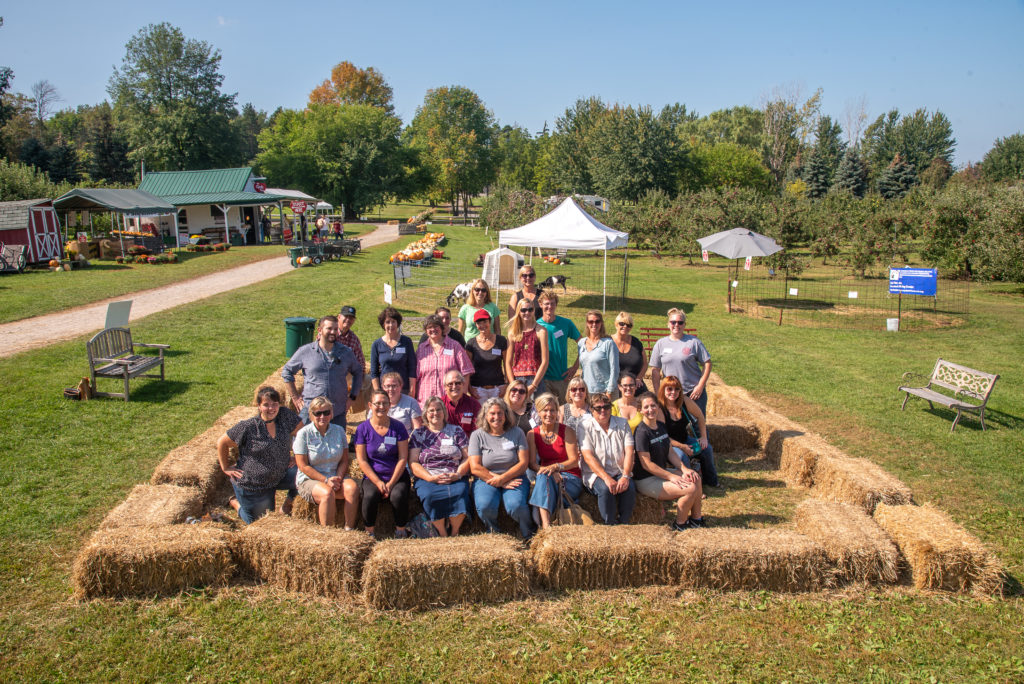
Farm Tours are a great way for growers and producers to gather community members and stakeholders and provide an intimate look at their operation. R.J. Anderson/Cornell Cooperative Extension
Neighbor Relations. This is the “why bother” that makes the most sense. Neighbors can be great supporters of the farm -but it takes time spent building that relationship and trust. An open invitation to visit the farm and go on a quick tour can be a great leap for both the farmer and the neighbor. A good neighbor that understands the farm business can be an advocate, a voice of support at the town hall meeting, or at least be a little more understanding when they hear the combine still going at 2 o’clock in the morning. As historically farm areas become more and more developed, our neighbors no longer have the common understanding of agriculture that used to ground our rural communities. This can create distrust based on misunderstanding, causing you headaches and angst. An invitation to the farm could be a great step towards building that mutual understanding.
Consumer Relations. The average consumer is 2.5 generations removed from the farm. As mentioned previously, we’re losing that common base of understanding how our food is produced. This creates distrust between the farmer and the consumer. However, 2.5 generations removed or not, we all need to eat – and we all need food grown by farmers. A farm tour can be a vehicle for consumers to better understand how their food is produced, and that it is coming from real-life people with families of their own. Something that might have seemed terrifying on a documentary they streamed, might be an everyday practice easily explained on a farm tour. Farm tours show a dedication to transparency, and an effort towards sharing our farming stories. Also, research has shown that one person will share their experiences with 22 others – good or bad. If you can provide one positive experience on a farm tour, that person will then share their positive vibes with 22 of their friends and family members. This type of genuine “recommendation” from a trusted member in friend circles can go a lot farther than a scary documentary or social media post.
Diversified Income. There are farms that are out there utilizing farm tours as a source of income. Is it easy to do that? Definitely not. BUT if you enjoy hosting farm tours and live in an area with enough of an agritourism interest to support that part of your operation, farms tours can provide an alternative stream of revenue for the farm business, as well as new customers for products you might sell directly to consumers. Throw in a petting zoo, a food truck, and maybe even some farm branded apparel and you’re a destination.
Education. Farm tours that incorporate school groups are often requested as part of a teacher’s curriculum. A visit to the farm provides an opportunity to tie in concepts learned through math, science, technology, and life-skills units. It’s unfortunate that agricultural curriculum is near non-existent in many schools, but a farm tour can provide a glimpse into an industry that offers many career opportunities (as well as feeds the world).
Good Excuse to Clean. And here we have the unexpected “why bother”. Rarely does someone go through the farm tour process to help clean up the farm, but is a great feeling to drive by and see those back corners weed wacked, the broken equipment moved into the pole barn, and the bale plastic safely disposed. While we all strive to have a picture perfect farmstead 365 days a year, a farm tour can help give a deadline and a goal to make it actually happen – at least for a few days.

Katelyn Walley-Stoll
OSU Extension Service
- Community vitality
- Agritourism
Adding agritourism: How to create successful tours for your farm or ranch
Hosting tours on your farm or ranch not only provides additional income but helps tell an important story about Oregon agriculture, rural communities and local food production. Below are key topics to consider when deciding whether or not to add farm tours to your business.
Deciding what to demonstrate
Determining points of interest on your operation is a first step in setting up a farm tour. While certain farming aspects may not seem interesting to you as the operator, the general public may find them intriguing.
Keeping your visitors entertained and safe are the main goals.
One way to decide what should be showcased on the tour is by walking friends or other producers around your property and taking note of what they notice and find most interesting. Create a route around these points of interest while avoiding potentially dangerous or unattractive areas.
Keeping your visitors entertained and safe are the main goals. For example, farm animals always delight visitors but could pose a safety risk. When choosing whether to include animals on the tour, take into consideration their health, friendliness, barn facilities and handwashing options.
Facilities on the farm
Now that you have determined the points of interest on your operation, it is time to consider the facilities.
Restroom facilities are a major factor on whether you can offer farm tours. What is the current public restroom situation? Does the farm have a septic system and can the system support the number of visitors anticipated? You may need to rent portable restrooms, whether seasonally or year-round.
Upon arriving, your guests should find clearly marked parking and be able to gather in an area out of weather.
Another consideration is parking. Upon arriving, your guests should find clearly marked parking and be able to gather in an area out of weather. Make sure the footing is as level as possible to make getting in and out of cars as easy as possible for the visitors. If your farm is open to the public you may need to comply with ADA regulations.
For schools and large groups that arrive in buses, there are some additional things to consider. Will this space be available at all tour times? Can a larger vehicle get in, turn around and get out of the space fairly easily? Is the ground going to be soft at certain times of the year, causing the possibility of stuck vehicles?
If bus parking is tricky or not possible, make sure you communicate this during the booking process or reconsider the tour size your farm can accommodate.
General farm tours or topic specific?
When planning a tour, think about what type it will be. Is the tour going to cover the farm in a general sense or is it going to showcase a specific aspect or activity on the farm?
Themed tours are one way to show different aspects of the farm and attract visitors interested in specific topics.
For example, if you have an orchard operation with a farm stand where you sell pressed cider, you could give a general tour of the whole operation or a cider-themed tour highlighting where the apples are grown, pressing and processing the cider, bottling and distribution.
Themed tours are one way to show different aspects of the farm and attract visitors interested in specific topics. Themed tours may change throughout the year featuring seasonal activities. A few examples of these types of tour are: soil restoration, orchard care, renewable energy, animal husbandry and crop production.
Self-guided tours
Organizing a self-guided tour is one way you can offer the tour experience without having to staff the position or lead the tour yourself. A successful self-guided tour needs good signage, well-marked routes or trails, and a map for the guests to follow. The map may point out interesting things such as buildings or plants and offer guidance, indicating rough terrain and off-limit areas.
A successful self-guided tour needs good signage, well-marked routes or trails, and a map for the guests to follow.
We recommend that there is a person to greet visitors upon arrival and to answer questions.
An interactive option for a self-guided tour is a scavenger hunt, a list of locations to visit or items to find. This can be an engaging and organized way to have visitors tour the operation without a personal guide. A small prize or incentive may be offered for a completed scavenger hunt such as a drawing entry, coupon, or free gift.
While this style of tour requires minimal staffing, it may lose the personal touch of having an actual tour guide. Lack of supervision may also lead to visitors in areas that are not desired or off limits.
Tours for school groups
When designing a tour for school groups and children, there are a few additional factors to consider. Tours for children should be a faster pace and include activities that are hands-on and educational.
The age of the children should also be kept in mind. A tour and the corresponding information and activities for middle school students may not hold the attention of elementary school students.
Field trips can be a large expense for schools so it is important to follow through with what has been promised.
Also, it’s helpful to have specific days and timeslots set aside for larger groups when scheduling school tours so you can be prepared with extra staff and activities if needed. When booking group tours, be sure to review the itinerary and expectations so that teachers can be prepare students and have adequate volunteers.
Field trips can be a large expense for schools so it is important to follow through with what has been promised and give consistent, well-planned educational experiences. For more information and resources on farm school tours, please visit the Oregon Farm to School program.
Budgeting for tours
Consider how tours fit into your business plan. You may choose to provide short tours at no cost that draw customers to your farm to purchase your farm products or design in-depth educational tours that share about farm production and generate additional income. Either way, tours require additional staffing.
Charging for tours may be less risky than offering free or low-cost tour and hoping customers buy product.
To determine a tour cost, take into account expenses versus possible income. Income includes registration cost of the tour plus farm stand purchases, as offering tours can lead to more product purchases. Expenses may include staff time coordinating and hosting the tours, value of products sampled, advertising, signage, self-guided tour brochures and keeping facilities tidy and welcoming. Use a break-even analysis to determine the minimum amount of guests per tour to make these activities profitable.
Charging for tours may be less risky than offering free or low-cost tour and hoping customers buy product. However, you can encourage sales of farm products by ending at a farm store or place to purchase your farm products. Each operation is unique and one budget does not work for all.
Tour registration
Developing a way to keep track of your tour schedule is critical so that you are prepared and ready to welcome guests. Scheduling can be as simple as guests contacting the farm via phone or email and scheduling on a calendar, an organized computer spreadsheet or using a more advanced scheduling program such as Bookeo.
Before booking, you should know the minimum and maximum guests per tour.
Before booking, you should know the minimum and maximum guests per tour. Also, consider whether a deposit is required or if a late or no-show policy is right for you. Selling advanced tickets using online platforms such as Eventbrite, Brown Paper Tickets or through your farm website is another option.
Importance of customer service
Customer service and hospitality are essential for the staff, whether it's you or an employee leading the tours. When leading a farm tour, the guide is the face of the farm so having staff members who are energetic and social and have skills working with the public is important.
Explain the farm products in an easy and sequential way and use sensory elements when possible.
The tour guide should always introduce themselves and say what their position is on the farm. The guide is setting the tone of the tour so let the group know at the beginning if they can ask questions during the tour, where the restrooms are and how long the tour will take, etc. If the tour is longer than an hour, consider providing a rest stop where guests can sit, get out of the weather and possibly have a refreshment.
Explain the farm products in an easy and sequential way and use sensory elements when possible. Seeing, hearing, smelling and tasting may ingrain that farm experience deeper and make it more relatable to the guest. If visitor attention is diverted, stop and talk about what caught their interest and make it a teachable moment.
Photo opportunities with farm signage are fun for guests and provide another source of advertising as guests often share photos on social media.
At the end of the tour be sure to say thank you and explain what else there is to do on their farm visit. Can guests walk around the buildings? Are there places to picnic or stay after the tour?
Lastly, asking guests for a post-tour review, whether on paper or electronically, may help with feedback to improve the tour.
Safety and risk management
When welcoming visitors onto the farm, minimizing your risk and keeping everyone safe are priorities. Be sure that your liability insurance policy is up to date and covers the activities you provide.
It is your responsibility to minimize hazards as much as possible.
In Oregon, limited-liability signage is available to inform guests that they are entering a working farm and there are inherent risks with doing so. To be protected by this regulation, the signs must be placed at the entrance of the farm and at key points where agritourism activities are taking place.
You may make your own regulation sign, as long as the lettering is one inch in size and includes the language as listed in the law, or purchase one from Oregon Agritourism Partnership or Plate and Pitchfork . More information about ORS 30.671 to 30.677 can be found online.
It is your responsibility to minimize hazards as much as possible. This may include walking surfaces, structures, walking paths from cars and farm equipment. Animals that are unsafe or unhealthy should be removed from public view.
Make sure the correct warning signs are displayed and visible. Examples of warning signs are: electric fences, no climbing on hay bales or farm equipment, wet and slippery surfaces, guard dogs on duty, and moving machinery.
Promoting the tour
Promoting farm and ranch tours is not just limited to websites and social media. Partnering with other businesses to cross-promote can be beneficial for all involved. For instance, if a berry farm sells its products to a bakery for pies, the bakery may advertise for the farm tours.
Partnering with other businesses to cross-promote can be beneficial for all involved.
Connecting with lodging establishments may also help bring new visitors to the farm and give the lodging operators a confident recommendation to their guests who are looking for local activities.
Lastly, always keep websites and social media up to date with photographs and videos to give potential guests a sneak peek of the operation and what to expect when they visit.
- How to Develop a Farm Tour
- Oregon Farm to School program
- Oregon Agritourism Partnership Regulation Limited Liability signs
- ORS 30.671 to 30.677
- Plate and Pitchfork Regulation Limited Liability signs
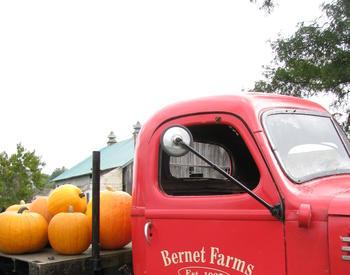
Was this page helpful?
Related content from osu extension.

New OSU study values annual economic impact of Willamette Valley agritourism at nearly $1 billion
Agritourism can take the form of farm-direct sales, education, entertainment, outdoor recreation and hospitality.
Chris Branam | Mar 21, 2024 | News story

OSU Extension helps Warm Springs tribal members loop back to food preservation
In 2022, 14 Warm Springs community members, primarily elders, went on the Warm Springs Fruit Loop tour. The canning classes held afterward helped participants refresh their skills and get caught up on any changes to methods.
Tracy Wilson | May 2023 | Impact story
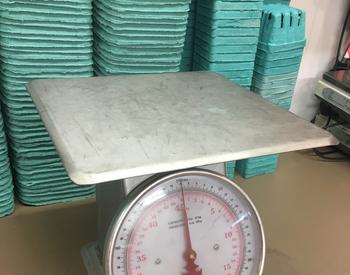
How to sell produce: by count, volume or weight?
One of a farm's first decisions when setting up to sell produce directly to consumers is how to measure and sell the produce. There are three choices: by count, volume or weight. Here's what to consider.
Mary Stewart | Aug 2019 | Article Peer reviewed (Gray level)

Adding agritourism: How to cultivate neighbor and farmer relations to avoid conflict
Agritourism promotes public support for agriculture. But it can also bring traffic and crowds to rural areas. That's why agritourism operators need to cultivate good neighbor relations to avoid conflicts.
Melissa Fery, Audrey Comerford | Feb 2020 | Article Peer reviewed (Gray level)

Extension support of farm loops helps connect people to local food systems
The OSu Extension Agritourism program supports farms that allow the public onto their land and has delivered successful initiatives in recent years that help farmers find another financial stream to keep them on the right side of the profit margin.
Audrey Comerford | Mar 2023 | Impact story
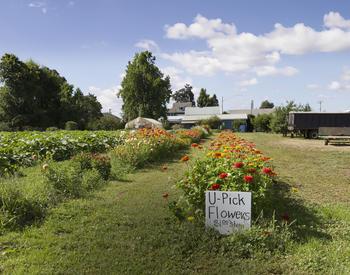
An Initial Economic Impact Estimate of Agritourism in Oregon's Willamette Valley
This study quantifies the economic effects of agritourism on Willamette Valley farms and communities. In surveys, farmers reported earning about 50% of their revenue from agritourism.
Bruce Sorte, Melissa Fery, Audrey Comerford | Feb 2024 | Extension Catalog publication Peer reviewed (Orange level)
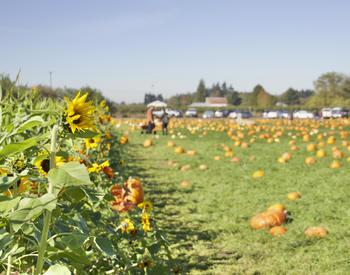
Executive Summary: An Initial Economic Impact Estimate of Agritourism in Oregon’s Willamette Valley
In agritourism, producers combine farming with some aspects of tourism. Get the key takeaways from a new report on agritourism in the Willamette Valley.

Oregon Small Farms Newsletter
From their website: Oregon Small Farm News is a free online newsletter that concentrates on both commercial small farm entrepreneurs as well as non-commercial small acreage landowners. Our focus embraces organic/biological and ...
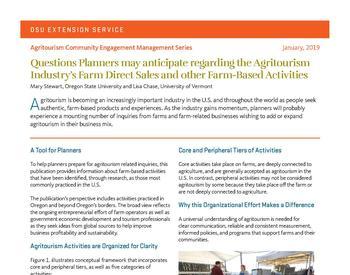
Questions planners may anticipate regarding the agritourism industry’s farm-direct sales and other farm-based activities
As agritourism grows in popularity, economic planners can expect to see more inquiries from farmers about how to add agritourism to their business mix. Here's a snapshot of U.S. agritourism activities to aid planners.
Mary Stewart, Lisa Chase | Mar 2019 | Article Peer reviewed (Gray level)
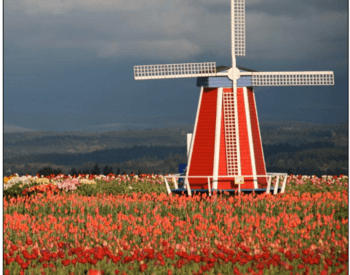
Increasing Farm Viability Through Agritourism and On-Farm Direct Sales: An Oregon Producer Survey
Agritourism is a way for farms to increase their business success. This survey explores how small farms are expanding beyond basic production, adding value and claiming more consumer support.
Mary Stewart, Audrey Comerford, Bruce Sorte, Sam Angima, Lisa Chase, Weiwei Wang, Rebecca Bartlett, David Conner, Chadley Hollas, Christopher Brittain, Lindsay Quella | Jul 2021 | Extension Catalog publication Peer reviewed (Orange level)
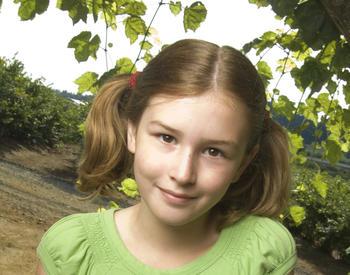
On-farm Agritourism Activities in Marion County, Oregon from 2017 to 2018
This study describes the scope of on-farm or core agritourism activities offered to visitors on 75 agritourism operations in Marion County during a study period spanning 2017 and 2018. It shows the types and numbers of activities offered, the seasons of agritourism, and reveals the average and median acreage and land use districts typical of agritourism operations. This initial information provides a benchmark for future measurement of the industry segment in Marion County.
Mary Stewart, Weiwei Wang | Sep 2019 | Publication Peer reviewed (Gray level)

Agritourism in the Mid-Willamette Valley
Agritourism connects consumers and tourists with agricultural products and places. It’s a way for producers on farms and ranches to diversify their business.
Mary Stewart, Michael Calcagno | Jul 2019 | Video
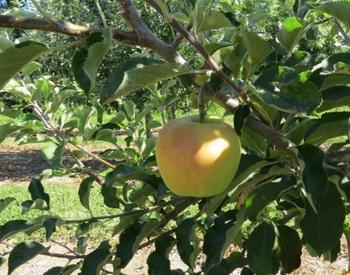
Seasonality Chart: What's in Season in the Region
From fruits to flowers and meat to fiber, this chart will help determine what agriculture products are in season and available directly from farms in the Willamette Valley region.
Mary Stewart, Colton Harms | Aug 2019 | Fact Sheet Peer reviewed (Gray level)

Shop at the Dock Garibaldi: An Interview with Julia Wentzel from Food Roots
Meet Julia Wentzel of Food Roots and learn more about their Farm Table store and how you can access flash frozen, locally caught seafood in Tillamook County during the Covid-19 pandemic.
Amanda Gladics | May 2020 | Video
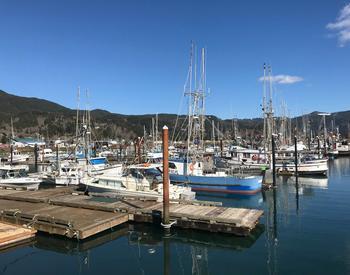
Shop at the Dock Garibaldi: An Interview with commercial fisherman Brian Trotter, Part 1
Learn from Brian Trotter, a commercial fisherman from Garibaldi, about his fishing business and how he's keeping seafood on our plates while reducing his risks during the Covid-19 pandemic.
Amanda Gladics | Apr 2020 | Video
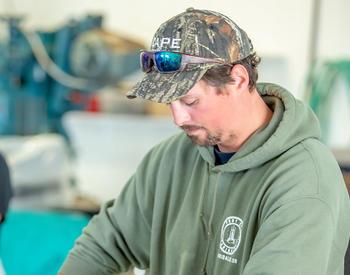
Shop at the Dock Garibaldi: An Interview with Jeremy Zeller from FishPeople's Market
Learn more about the FishPeople's Market, one of the usual tour stops on the Shop at the Dock program in Garibaldi. We talk with Jeremy Zeller, the landings supervisor, to learn more about what how he's keeping his employees...

Shop at the Dock Garibaldi: Accessing Seafood during COVID-19
Learn more about the Shop at the Dock program in Garibaldi, and what you need to know about eating seafood during the novel coronavirus (COVID-19) pandemic.

Shop at the Dock Garibaldi: Interview with Amanda Cavitt of the Garibaldi Bistro
Meet Amanda Cavitt, the General Manager of the Garibaldi Portside Bistro. She shares her insights on keeping seafood on the menu during the COVID-19 pandemic, how they prepare their smoked albacore tuna melt, and her advice for learning how cook seafood at home.

Have a question? Ask Extension!
Ask Extension is a way for you to get answers from the Oregon State University Extension Service. We have experts in family and health, community development, food and agriculture, coastal issues, forestry, programs for young people, and gardening.
- Search Search Please fill out this field.
- Manage Your Subscription
- Women in Agriculture
Why Farmers Need to Host Tours
The 98% of the population not connected directly to agriculture can help tell our story – but only if we invite them to hear it.
"I couldn't work outside in this heat all day, every day."
"I read a number of business magazines that include interviews with CEOs. Why don't they ever interview farmers?"
"I've been using terms related to how food is grown in my posts without giving any thought to why I am using them."
"I see they have some of the same challenges on their farm that we do."
These are all comments I've heard after touring farms with a variety of groups including food bloggers, registered dietitians, teachers, mothers, school nutrition staff, 4-Hers, and other farmers.
Farm tours are important for many reasons. With most of the population at least two generations removed from farming, it gives people interested in how food is produced an opportunity to make connections with farmers. Many people talk about food, its nutritional value or how to cook it, but have never actually visited a farm, talked to a farmer, or had any education on how food is grown, except maybe their own experience as a home gardener.
During a visit they can hear your story – why you farm, how you farm, and how your farm has changed. If they can experience it, even better. Last year I took a group to a farm where they planted cabbage. It looked easy, until they were seated on the setter, trying to drop a plant into each hole as the tractor slowly moved across the field. After we finished, one participant remarked we did such a bad job planting we'd be fired and they felt bad for whoever had to come behind us to fix the mess we'd made of the rows.
One farmer talked about how her third-generation farm had always grown landscape plants and Christmas trees, but the birth of her son changed things. It takes at least seven years for Christmas trees to be ready for harvest, and that wasn't holding his interest. The farmer realized she better start growing something else if she wanted her son to be involved in the farm. She switched to fruits and vegetables and now he can see the fruits of his labor in one growing season – a much easier way to capture a teenage boy's interest.
Last week I visited dairy and grain farms and heard how important technology is. The grain farmer can run irrigation equipment from an app on his phone. The dairy farmer showed us the system that monitors the milk cooling process, storage of milk, and tank cleaning. If the temperature gets off by even 1°F., it sends an alarm to the farmer so he can check the system.
Even if the group you are hosting is farmers, it's important for them to learn about your farm. I can tell you about the crops we grow on our farm, but don't ask me about livestock or strawberries or apple trees. Those aren't part of my story, but maybe they are part of yours. I've shared many other farmers' stories in talking with consumers, stories I only knew from visiting the farm and talking with the farmer. I had a chance to talk with a cranberry farmer last fall, and have talked about what I learned from him many times since.
They can see and experience food safety at the farm level firsthand. I've been on tours where we had to disinfect our shoes; wear booties, hairnets, or other protective equipment; wash our hands; or follow strict guidelines when picking crops. Hearing about food safety is one thing – experiencing it takes that understanding to a new level. Years ago, I visited a hog farm with a group of 4-H members. We had to shower before going inside the barn, wear the jumpsuit and boots they provided, and shower again on our way out the door. Following the same biosecurity precautions as the people who worked there left an impression on how important keeping the animals healthy was – an impression I can vividly recall almost 15 years later.
People walk away from a farm tour with a better appreciation for the work farmers do. I've seen post-tour blogs that detail the sweat dripping down participants' backs as they picked crops and how they wouldn't want to do this every day. I've seen comments about the skill it took to pick fruits and vegetables. An awareness of how complex farming is, how many people it employs, and all the skills farmers must have today. I know after visiting an oyster farm I left with a new appreciation for what it takes to raise oysters and how long – two years until harvest. After seeing it takes six months for some types of cheese to cure, I don't complain about the cost. Watching a farmer stand in the middle of his field, eating romaine lettuce he just picked is a great visual reminder that farmers eat what they grow.
I also think it's important for participants to see how farms are not the same, even if they grow the same crops or raise the same type of livestock. They see how diverse farms are not only in how many crops they grow or livestock they raise, but in size, as well. I've lost count of how many cattle farms I've been on, but I remember that no two were alike. People need to see that farmers are like fingerprints – each one is unique. That can only happen if we open our doors.
I get it. Inviting people you don't know onto your farm is scary, particularly in today's climate. You wonder if they are coming with an open mind and willing to talk about what you do and why, or if they are full of preconceived ideas that won't change. If they will take photos or video then post them online in a manner that doesn't accurately portray what was happening. If they will say negative things because your farm doesn't fit what their idea of a farm should be.
But if we don't open our doors, how will they know our stories? How will they meet the families who live and work on these farms? How will they find out what we do and why in order to grow food that many take for granted? That 98% can help tell the story of our 2%.
If we don't show them our farms and share our stories, someone else will. Someone else already is.

Defining the Bounds of Booming Agritourism
- Jessica Guarino, Renata Endres, Tyler Swanson, and Bryan Endres
- Department of Agricultural and Consumer Economics
- University of Illinois
Traditions of seasonally visiting pumpkin patches, harvest-your-own operations, and other on-farm activities are well worn into our cultural practices. Beyond the communal and educational elements these operations evoke by providing the public a hands-on connection to food and agriculture, the agritourism industry has grown substantially over the past decade in response to economic pressures on both farmer and consumer as well as growing interest in locally produced food. [1] Agritourism operations offer income diversification opportunities to farmers while simultaneously providing community members with recreational, educational, and entertainment prospects. Because the nexus between agriculture and tourism presents the public with unique opportunities, many states have or are considering efforts to encourage the industry’s development via various types of legislation. Legislation limiting liability for certain activities intrinsic to agritourism is among the most common. To provide liability exemptions to agritourism operations, though, scoping and defining the bounds of agritourism is necessary.
The USDA does not have a formal, regulatory definition for agritourism, but describes it as “a form of commercial enterprise that links agricultural production and/or processing with tourism in order to attract visitors onto a farm, ranch, or other agricultural business for the purposes of entertaining and/or educating the visitors and generating income for the farm, ranch, or business owner.” [2] The first national law defining agritourism was passed in Italy in 1985 and “focused on overnight stays that support the restoration of farm buildings and the diversification of income sources for the working farms in rural areas.” [3] Since then, both agritourism as a practice and its definition have greatly expanded, encompassing many elements of both tourism and agriculture.
Several studies across disciplines and continents have attempted to synthesize a definition of agritourism, and while many definitions of agritourism remain, the literature reveals some core components. Tourism studies literature provides one of the broadest agritourism definitions, describing it as “an entrepreneurial endeavor with the purpose of attracting visitors to the farm,” and allows for a five-class theoretical typology of agritourism operations: “nonworking farm agritourism; working farm, passive contact agritourism (e.g. bed and breakfast on a current farm); working farm, indirect contact agritourism (on-farm dining); working farm, direct contact, staged agritourism (e.g. appreciation of farm demonstrations; and working farm, direct contact, authentic agritourism (e.g. participation in farm chores).” [4] Unfortunately, these wide-ranging definitions make developing a legal definition allocating liability exemptions challenging.
In addition to the widely recognized economic benefits agritourism operations bring farmers and surrounding communities, recent research defining agritourism highlights the environmental and cultural resiliency aspects available through agritourism, including “fostering wildlife habitat improvement and water conservation, preservation of rural heritage and reconnection with agrarian culture, and increasing employment of family and non-family.” [5] Much of the literature on defining agritourism highlights its fluid nature, highly dependent upon the “type of setting . . . type of activity or interaction . . . and level of authenticity: the means of presenting or experiencing the agricultural reality.” [6] Despite considerable research devoted to delineating the distinction between agricultural tourism and other rural/countryside tourism, many definitions of agritourism functionally encompass elements of both. [7] Accordingly, a legal definition of agritourism would not want to exclude or unduly limit these critical environmental and cultural resiliency characteristics.

Federally, a bill was introduced in the House of Representatives on January 13, 2022, to create a Department of Agritourism. [12] This bill, also known as the “Accelerating the Growth of Rural Innovation and Tourism Opportunities to Uphold Rural Industries and Sustainable Marketplaces Act” or “AGRITOURISM Act” defines agritourism by the experiences it provides:
- Education , such as school tours, garden and nursery tours, winery tours, historical agricultural exhibits, and hops and micro-brewery tours;
- Outdoor recreation , such as river activities, mountain biking, horseback riding, wildlife viewing and photography, fee fishing and hunting, wagon and sleigh rides, cross-country skiing, game preserves, and clay bird shooting;
- Entertainment , such as concerts and special events, culinary experiences, festivals, fairs, interaction with farm animals, and weddings;
- Direct sales , such as on-farm sales, farm stands, agriculture-related crafts and gifts, u-pick operations, u-cut tree farms, wineries, breweries, cideries, distilleries, and cut flowers;
- Accommodations , such as bred-and-breakfast inns, farms and ranch vacations, yurts, sheep wagons, and guest ranches; and
- Dining on a farm. [13]
Further, the proposed AGRITOURISM Act explicitly names some of the benefits that agritourism operations offer, including “educational opportunities for children and families”; “supplemental income for owners of agricultural enterprises, which are often small or family-run businesses”; “economic development in rural communities”; “preserve agricultural heritage”; and “help farms diversify.” [14] The interest in devoting an entire department to the promotion and regulation of agritourism indicates its rising importance.
At the state level, legislation limiting liability for a variety of industries is well-established. Agritourism operations are especially vulnerable in instances where a visitor may be hurt while performing on-farm activities, including “picking produce, feeding livestock, climbing on straw bales, engaging in recreational activities, and riding on wagons, tractors and horses.” [15] Lawsuits can be economically devastating for an agritourism enterprise, making legislation providing immunity from liability in certain instances helpful to farmers in managing financial risk. [16] The results of a 2021 survey conducted by the University of Vermont Tourism Research Center noted that nationally, nearly 80% of respondents listed concerns about agritourism liability issues as a challenge to them as operators; an additional 80% of respondents listed the cost and availability of insurance as another challenge. [17] Without legislative immunity, lawsuits against agritourism operators turn on more uncertain and amorphous analyses, including whether the operator acted with “reasonable care” or the “open and obvious” doctrine that protects landowners from liability for injuries resulting from clear dangers like aggressive animals at petting zoos or falls off hay rides. [18]
In Illinois, a bill creating an Agritourism Liability Act has been introduced twice to the state legislature, but both times the legislative session ended before the bill was voted on. [19] Similar to other state-level civil liability laws covering or directly addressing agritourism, [20] the Illinois Agritourism Liability Act would protect farms by granting immunity from liability for certain activities closely connected to the agritourism operation. [21] The bill defines “agritourism activity” broadly as any activity carried out on a farm or ranch that allows members of the general public, for recreational, entertainment, or educational purposes, to view or enjoy rural activities . . . [including, but not limited to]: farming; ranching; historic, cultural, and on-site educational programs; guided and self-guided tours; animal exhibitions; farm festivals; corn mazes; harvest-your-own operations; hayrides; fishing; and camping. [22]
Additionally, the bill provides “that an agritourism operator is not liable for injury or death of a participant resulting from the inherent risks of agritourism activities if the agritourism operator posts the required warning notice,” as well as “provides that a participant assumes the inherent risks of an agritourism activity by engaging in the agritourism activity.” [23] Despite the lack of action by the state legislature, the Agritourism Liability Act continues to garner support from various stakeholders such as the Illinois Specialty Growers Association and Illinois Farm Bureau. [24] Though agritourism presently lacks liability immunity for agritourism’s inherent risks, Illinois currently has limited liability acts for similar educational and entertainment experiences like horse riding through the Equine Activity Liability Act. [25]
As agritourism operations continue to expand in Illinois and across the nation, and as legislatures consider liability exemptions, it is important to carefully consider the scope and impact of the law. Legislation and implementing regulations should “clearly articulate which activities are subject to immunity provisions as well as the steps required for operators to secure immunity from liability (e.g., waivers, warning signs).” [26] Absent this clarity, the law could create more litigation regarding the scope of exemptions rather than providing relief. It is also important to consider what economic benefit, if any, likely accompanies these exemptions. Whether legislation limiting liability for agritourism operations reduces insurance costs (and by how much) and if immunity from liability deters lawsuits has yet to be studied. Further research into the economic impact of liability limitations on agritourism operations, as well as the social and political ramifications (e.g., whether legislation merely signals state support or has an actual impact), will hopefully illuminate this data.
[1] Defining and Regulating Agritourism, Trends in State Agritourism Legislation 2019-2020, Center for Agriculture and Food Systems, University of Vermont, https://www.vermontlaw.edu/sites/default/files/2021-04/Defining-and-Regulating-Agritourism.pdf.
[2] National Agricultural Library, Agritourism and Farm Tours , U.S. Department of Agriculture, https://www.nal.usda.gov/legacy/afsic/agritourism-and-farm-tours (last visited Feb. 8, 2022).
[3] R. David Lamie et al., Agritourism Around the Globe: Definitions, Authenticity, and Potential Controversy , J. of Ag, Food Systems, and Community Development (2021).
[4] Carla Barbieri, Assessing the Sustainability of Agritourism in the U.S.: A Comparison Between Agritourism and Other Farm Entrepreneurial Ventures , J. of Sustainable Tourism (2012); Sharon Philip et al., A Typology for Defining Agritourism , Tourism Management (2010).
[5] Sara Brune et al., The Influence of Agritourism Experiences on Consumer Behavior Toward Local Food , J. of Travel Research (2021), https://journals.sagepub.com/doi/pdf/10.1177/0047287520938869.
[6] Thomas Streifeneder, Agriculture First: Assessing European Policies and Scientific Typologies to Define Authentic Agritourism and Differentiate it from Countryside Tourism , Tourism Management Perspectives (2016).
[7] See, e.g. , Id.
[8] Ark. Code Ann. 2-11-103. Defines Agritourism as “an interactive or passive activity carried out with
or without payment to an agritourism activity operator on a farm, ranch, or agribusiness operation related to agriculture, food production, historic traditions, or nature watching conducted by an agritourism activity operator for the education, entertainment, or recreation of participants. It includes without limitation a farming or ranching activity, the viewing of historic, cultural, or natural attractions, a harvest-your-own activity, nature-watching,
and an activity involving an animal exhibition at an agricultural fair.” Id.
[9] Defining and Regulating Agritourism, supra note 1.
[10] R. David Lamie et al., Agritourism Around the Globe: Definitions, Authenticity, and Potential Controversy , J. of Ag, Food Systems, and Community Development (2021).
[11] R. David Lamie et al., Agritourism Around the Globe: Definitions, Authenticity, and Potential Controversy , J. of Ag, Food Systems, and Community Development (2021).
[12] H.R. 6408, 117 th Congress, 2 nd Sess., https://www.congress.gov/117/bills/hr6408/BILLS-117hr6408ih.pdf
[15] Peggy Kirk Hall and Evin Bachelor, Agritourism Immunity Laws in the United States , The National Agricultural Law Center (2019), https://nationalaglawcenter.org/wp-content/uploads/assets/articles/Agritourism-series-Immunity-laws.pdf.
[17] Lisa Chase et al., Agritourism and On-Farm Direct Sales Survey: Results for Vermont , University of Vermont Extension (2021), https://www.uvm.edu/sites/default/files/Vermont-Agritourism-Collaborative/VT_Survey_Report.pdf.
[18] Hall, supra note 14; Peggy Kirk Hall and Ellen Essman, Recent Agritourism Litigation in the United States , The National Agricultural Law Center (2020), https://farmoffice.osu.edu/sites/aglaw/files/site-library/AgritourismLitigationHallFinal.pdf.
[19] IL SB458, https://www.ilga.gov/legislation/BillStatus.asp?DocNum=4315&GAID=15&DocTypeID=HB&SessionID=108&GA=101
[20] Defining and Regulating Agritourism, supra note 1.
[21] IL SB458, https://www.ilga.gov/legislation/BillStatus.asp?DocNum=4315&GAID=15&DocTypeID=HB&SessionID=108&GA=101
[23] IL SB458 https://www.ilga.gov/legislation/BillStatus.asp?DocNum=4315&GAID=15&DocTypeID=HB&SessionID=108&GA=101
[24] See, e.g. , https://www.specialtygrowers.org/agritourism-liability-act.
[25] 745 ILCS 47
[26] Defining and Regulating Agritourism, supra note 1.
Disclaimer: We request all readers, electronic media and others follow our citation guidelines when re-posting articles from farmdoc daily . Guidelines are available here . The farmdoc daily website falls under University of Illinois copyright and intellectual property rights. For a detailed statement, please see the University of Illinois Copyright Information and Policies here .
Related Posts
- It’s Pumpkin Patch Season and Agritourism is Booming—But What Exactly is Agritourism?
- Mapping the Farm Bill: Reviewing the CRP; Law, Land & History
- Market Prices
- farmdoc Team
- Ryan Batts (34)
- Joana Colussi (57)
- Jonathan Coppess (482)
- A. Bryan Endres (40)
- Jason Franken (28)
- All Articles
- Biodiesel Production Profits
- Biodiesel Supply
- Ethanol Outlook
- Ethanol Production Profits
- Gasoline Blending
- Gasoline-Diesel Prices
- Renewable Diesel Boom
- Biodiesel Tax Credit
- RIN Market and Pricing
- SREs and the RFS
- Milestones and Announcements
- USDA Reports
- Grain Miscellaneous
- Ending Stock Models
- New Era Projections
- Growing Season Yield Forecasts
- Late Planting Impacts on Yield
- Trend Yields and Yield Risks
- USDA Acreage and Production Reports
- Joe Janzen (62)
- Maria Kalaitzandonakes (27)
- Michael Langemeier (173)
- Dale Lattz (34)
- Gerald Mashange (6)
- Nick Paulson (565)
- Gary Schnitkey (1043)
- Bruce Sherrick (72)
- Mark White (8)
- Carl Zulauf (642)
- Brad Zwilling (154)
- All Authors
- April 2024 (9)
- March 2024 (20)
- February 2024 (21)
- January 2024 (21)
- December 2023 (20)
- November 2023 (18)
- October 2023 (21)
- September 2023 (20)
- August 2023 (17)
- July 2023 (21)
- June 2023 (21)
- May 2023 (20)
- April 2023 (20)
- March 2023 (23)
- February 2023 (20)
- January 2023 (16)
- December 2022 (18)
- November 2022 (18)
- October 2022 (13)
- September 2022 (17)
- August 2022 (21)
- July 2022 (13)
- June 2022 (19)
- May 2022 (19)
- April 2022 (18)
- March 2022 (15)
- February 2022 (15)
- January 2022 (13)
- December 2021 (14)
- November 2021 (11)
- October 2021 (10)
- September 2021 (12)
- August 2021 (14)
- July 2021 (12)
- June 2021 (15)
- May 2021 (16)
- April 2021 (20)
- March 2021 (22)
- February 2021 (14)
- January 2021 (17)
- December 2020 (13)
- November 2020 (14)
- October 2020 (16)
- September 2020 (18)
- August 2020 (16)
- July 2020 (22)
- June 2020 (21)
- May 2020 (18)
- April 2020 (21)
- March 2020 (26)
- February 2020 (19)
- January 2020 (21)
- December 2019 (17)
- November 2019 (19)
- October 2019 (23)
- September 2019 (20)
- August 2019 (25)
- July 2019 (20)
- June 2019 (20)
- May 2019 (22)
- April 2019 (23)
- March 2019 (22)
- February 2019 (19)
- January 2019 (21)
- December 2018 (18)
- November 2018 (18)
- October 2018 (20)
- September 2018 (18)
- August 2018 (22)
- July 2018 (21)
- June 2018 (21)
- May 2018 (22)
- April 2018 (21)
- March 2018 (21)
- February 2018 (20)
- January 2018 (20)
- December 2017 (16)
- November 2017 (20)
- October 2017 (22)
- September 2017 (18)
- August 2017 (22)
- July 2017 (20)
- June 2017 (18)
- May 2017 (22)
- April 2017 (19)
- March 2017 (22)
- February 2017 (20)
- January 2017 (20)
- December 2016 (15)
- November 2016 (20)
- October 2016 (20)
- September 2016 (20)
- August 2016 (22)
- July 2016 (20)
- June 2016 (21)
- May 2016 (20)
- April 2016 (20)
- March 2016 (23)
- February 2016 (20)
- January 2016 (19)
- December 2015 (22)
- November 2015 (19)
- October 2015 (22)
- September 2015 (21)
- August 2015 (20)
- July 2015 (19)
- June 2015 (21)
- May 2015 (20)
- April 2015 (21)
- March 2015 (23)
- February 2015 (20)
- January 2015 (19)
- December 2014 (19)
- November 2014 (17)
- October 2014 (23)
- September 2014 (22)
- August 2014 (25)
- July 2014 (21)
- June 2014 (21)
- May 2014 (22)
- April 2014 (22)
- March 2014 (19)
- February 2014 (22)
- January 2014 (21)
- December 2013 (19)
- November 2013 (19)
- October 2013 (23)
- September 2013 (20)
- August 2013 (21)
- July 2013 (21)
- June 2013 (20)
- May 2013 (25)
- April 2013 (22)
- March 2013 (21)
- February 2013 (22)
- January 2013 (21)
- December 2012 (18)
- November 2012 (20)
- October 2012 (23)
- September 2012 (19)
- August 2012 (24)
- July 2012 (22)
- June 2012 (21)
- May 2012 (23)
- April 2012 (20)
- March 2012 (20)
- February 2012 (21)
- January 2012 (19)
- December 2011 (19)
- November 2011 (18)
- October 2011 (18)
- September 2011 (21)
- August 2011 (22)
- July 2011 (21)
- June 2011 (23)
- May 2011 (21)
- April 2011 (26)
- March 2011 (17)
- February 2011 (13)
- Conservation and Other
- Environmental Policy
- Farm Program Analysis and Outlook
- Farm Program Description
- Food Policy
- Gardner Policy Series
- Risk Management
- Energy Markets
- Legal and Regulatory
- Profitability
- Renewable Fuels Standards
- Premiums and Payouts
- Prevented and Delayed Planting
- Land Prices
- Rental Arrangements
- Rental Forms
- Agricultural Credit
- Farm Income
- Financial Management
- Interest Rates
- Profitability Benchmarks
- Costs of Production
- Crop Economics
- Decision Aids
- Livestock Economics
- Machinery Economics
- Precision Conservation Management (PCM)
- Weekly Farm Economics
- Ag Market Insights
- Crop Yields
- Futures and Options Markets
- Grain Outlook
- Livestock Outlook
- Long-Term Outlook
- Marketing Strategies and Basis
- USDA reports
- Weekly Outlook
- Coronavirus (Covid-19) and Ag
- 20th Anniversary Series
- The State of Soybean in Africa
- AgMAS Reports
- Farm Economics Facts & Opinions (FEFO)
- Marketing and Outlook Research Briefs
- Marketing and Outlook Research Reports
- Weekly Outlook (Before 2011)
- Crop Insurance Decision Tool (Sheet)
- Crop Insurance Payment Evaluator
- Crop Insurance Premium Calculator
- ECO/SCO Payment Estimator (Sheet)
- Post Application Coverage Endorsement Tool (Sheet)
- Price Distribution Tool
- Farm Bill What-If Tool
- Balance Sheet & Historical Financial Statements
- Cash Rent with Bonus Worksheet
- Crop Insurance Decision Tool
- Farm Projection Tool
- Land Purchase Analysis
- Planting Decision Model
- Appraisal of Current Financial Position
- Beef Profitability Model
- Biomass Crop Budget Tool – Corn Stover
- Briomass Crop Budget Tool – Miscanthus & Switchgrass
- Capital Budgeting Analysis
- Carbon Calculator
- Cash to Accrual Income Approximation
- Corn & Soybean Basis Tool
- Cost of Feedstuffs Calculator
- Dairy Profitability Model
- Earned Net Worth Allocation
- Enterprise Allocation Module
- Estimation of Deferred Taxes
- Ethanol Dry Mill Plant Simulator
- Farm Rent Evaluator
- Grain Storage Purchase Analysis
- Grain Inventory Management
- Grain Pricing Tool
- Illinois Soil Productivity & Yield Utilities
- Lease vs Purchase Analysis
- Loan Amortization
- Loan Comparison
- Machinery Financing
- MACRS Calculator
- Marketing & Crop Insurance Risk Model
- Monthly Cash Flow Planning
- New Company Simulator
- Personal Financial Statements
- Quick Cash Flow Projections
- Repayment Capacity Analysis
- Revolving Loan Calculator
- Savings Calculator
- Specialty Commodity Breakeven Analysis
- Time Value Tools
- Yield Risk Evaluator
- Farmland LEasing Facts Sheets & Pricing Information
- Illinois Crop Budgets & Historic Returns
- Illinois Farmland Leasing & Rental Forms
- Machinery Cost of Operations Estimates
- Whole Farm & Other Reports
- 2018 Farm Bill What-If Tool (Sheet)
- ARC/PLC Calculator (Online)
- farmdoc daily live Archive
- 5-minute farmdoc Archive
- Illinois Farm Economic Summit
- IFES Archive
- Sponsorship Program
- Friends of farmdoc
- Donation Form
- Digging Deeper
- Connect / Subscribe
- 20th Anniversary
- Department of ACE
Consider an Agriturismo for Your Vacation in Italy
An Authentic Farm Stay in the Italian Countryside
:max_bytes(150000):strip_icc():format(webp)/martha_bio-56a3c8865f9b58b7d0d3b5fe.jpg)
If you're planning a trip to Italy and looking for accommodations , you'll likely come across the word agriturismo —a combination of the words for "agriculture" and "tourism" in Italian. An agriturismo is a farm stay, or a style of vacationing in farm house resorts.
In Italy, many agriturism i (the plural of agriturismo) are generally suitable for the whole family, and many have farm animals with which children can interact. Others are more romantic and perfect for a couples' getaway. Despite the quaint-sounding name, many agriturismo vacations are quite luxurious.
History of Italian Agriturismo
Starting in the 1950s and continuing through the 1970s, traditional small-scale farming in Italy became less profitable and many farmers abandoned their farms to search for work in larger towns.
However, Italians place great value and worth in their agricultural traditions, especially in the small-scale production of foods like cheese, wine, and olives. By 1985 Italian lawmakers had created a legal definition for Agriturismo, which allowed, and in some cases provided funds for, the rehabilitation and restoration of many abandoned rural buildings and estates.
Some were turned into vacation homes, and others were converted into agriturismo accommodations, similar to English or American bed and breakfasts. These agriturismi allowed small farmers to augment any income from the farm by hosting vacationers and providing them with the unique first-hand experience of the rural way of life in Italy.
What You'll Eat on an Agriturismo Vacation
An Italian agriturismo will usually serve guests food that was prepared from raw materials produced on the farm or from other local merchants. Some will allow the guests to participate in the activities surrounding the farm, such as picking the vegetables or milking the cows.
Despite the rural nature of the lodging, one might expect a rustic experience; though a great many agriturismi are high-end and feature amenities like swimming pools. Generally speaking, accommodations can run the gamut from simple rooms with rustic furnishings and shared bathrooms to ultra-deluxe suites or apartments with whirlpool bathtubs and other high-end perks.
Agritourism and the Italian Economy
The agritourism bet by the Italian government proved a boon for rural farmers who could no longer rely solely on their farms' output for income. At least a million tourists visit Italy annually to enjoy the scenic countryside in agriturismo lodgings.
Although the rural population in Italy has declined since the end of World War II, the agritourism sector has given new life to some areas of the country where there were few other options for new industry.
Types of Agriturismo
Agritourism is so popular that there are even subcategories of agriturismo accommodation. For those seeking an environmentally-friendly holiday, many farms offer ecotourism alternatives with total immersion in nature. Tourists seeking a little pampering may opt for a wellness agritourism experience at a farm that offers spa services and treatments.
Prefer to stay active on your vacation? You can choose an agritourism accommodation that includes horseback riding, climbing, swimming, and other sports and activities. And if you're all about the food (and who doesn't want to sample as much authentic Italian food as possible!), choose a culinary-centric agriturismo with food tastings and tours themed around the cuisine of the area you're visiting.
How to Select an Agriturismo in Italy
If you are considering an agriturismo, or farm stay, decide what kind of experience you want. An idyllic retreat in the countryside , or a hands-on experience of Italian farm life? You'll find agriturismo listings—they'll sometimes refer to themselves in English as country houses or holiday houses—on most major accommodation booking sites, as well as on the Agriturismo.it website. Wherever you search, be sure to read reviews, study photos and make sure the agriturismo meets your needs. Also consider what cities or towns are nearby—will you want to explore the surrounding area or will you be content to stay on the farm and enjoy a low-key stay? Whatever agriturismo you choose, you're sure to experience an authentic slice of Italian culture and rural life that you won't find in a hotel!
Article expanded and updated by Elizabeth Heath
The Best Places to Stay in Tuscany
Tuscany Guide: Planning Your Trip
How to Save Money on Your Italian Vacation
Trips to Sicily: The Complete Guide
The Most Impressive Unusual Accommodations in Italy
The 15 Best Destinations in Italy
Learn to Cook on Your Italian Vacation
Burano: Planning Your Trip
15 Ways and Places to Experience Rural India
Your Trip to Vermont: The Complete Guide
18 Farmstays in India to Get Back to Nature
Your Trip to Florence: The Complete Guide
20 Top Things to Do in Diverse India
Your Trip to Switzerland: The Complete Guide
Lake Como Guide: Planning Your Trip
The Most Romantic Places in Italy

Crawfish, Cranberries, and Cannabis: U.S. Farm Tours You Should Take
If your definition of a farm tour involves corn mazes, pumpkin patches, and hayrides full of screaming children, it’s time for a rewrite..
- Copy Link copied

At the family-owned James Ranch in Colorado, visitors can hang out with the animals and purchase items like raw-milk cheese and homemade jams.
Courtesy of James Ranch
Dovetailing with a booming interest in farm-to-fork eating, agritourism—wherein guests stay at or tour farms or other agriculturally related ventures—is a burgeoning sector of the travel industry. While you may not be ready to spend a summer herding sheep in Italy with WWOOF (World Wide Opportunities on Organic Farms), there are countless opportunities closer to home to learn more about where food comes from and who grows it. What follows are six insightful U.S. farm tours offering a behind-the-scenes look at modern agriculture, from organic cranberry farming in Cape Cod to goat milking in South Carolina.

Visitors to Ostlie’s in North Dakota can learn about hops, hardneck garlic, and haskap berries during a tour.
Courtesy of Ostlie’s Sunnyside Acres
Ostlie’s Sunnyside Acres Carrington, North Dakota
Lindsay and Mike Ostlie may grow haskap berries and hardneck garlic at their Sunnyside Acres farm in Carrington, two hours northwest of Fargo, but their hops are the real stars of the show. The couple sells most of its lupulin harvest to Fargo Brewing Company for use in its Farm Fresh beer ; the rest goes to Laughing Sun in Bismarck, Kilstone Brewing in Fargo, and various Dakotan home brewers. Day-trippers tour the couple’s vintage granary and sustainable hopyard, learning the many ins and outs of hops production along the way. Mike studied Crop & Weed Sciences in college, so he can really get in the weeds on the technical stuff (pun intended). Ostlie’s Sunnyside Acres is open for tours from June to September; reservations are required.
Cape Farm Supply & Cranberry Company Harwich, Massachusetts
Husband and wife Leo and Andrea Cakounes love showing guests around Cape Farm Supply & Cranberry Company , their organic cranberry bog—the largest on Cape Cod—and explaining the many ways that harvesting this native North American fruit differs from what you’ve seen in the Ocean Spray commercials. (You won’t be up to your knees in floating cranberries, for one; the bogs are only flooded during harvest season and that step lasts about 24 hours.) Andrea leads the 90-minute group tours, which dive deep on the growing process while weaving in humorous stories about working on the bog. Raising cranberries is a year-round endeavor, but tours are offered in spring, summer, and fall only. Sweet-tart souvenirs such as cranberry sauce, sweetened dried cranberries, and cranberry bog honey are for sale at the on-site farm stand.

Around 30 goats make up the herd at Burden Creek Dairy in South Carolina.
Photo by Hansje Gold-Kreuck
Burden Creek Dairy John’s Island, South Carolina
This charming Lowcountry goat dairy, located about 25 minutes from downtown Charleston, is a two-man operation—and both of these men were doing something different a few years back. Chris Maher was a chef before he became the cheesemaker-in-chief. Danny Sillivant was a real estate agent turned head herdsmen. They teamed up in 2017 and took over the Burden Creek Dairy , along with its herd of 30-something goats. Trixie, Edna, Pebbles, and the rest of the caprine gang are now considered to be their family, and the duo offers two-hour farm tours that travelers can book year-round via Airbnb Experiences , inviting them to try their hand at goat milking, to cuddle and bottle-feed the kids, and to sample some of the farm’s primo artisanal soft cheeses. (John’s Island Green, a chèvre made with garlic and seasonal herbs, and Sweet Sunset, a pineapple-mango goat cheese coated with chili powder, receive rave reviews.)
Crawfish Farm Tours Jeff Davis Parish, Louisiana
Although some crawfish are caught in local swamps and bayous, far more are raised on freshwater farms deep in Acadiana, the southern region of Louisiana that has historically been home to the Francophone population. From March through May, the Jeff Davis Parish Tourist Commission leads crawfish farm tours to Tietje Crawfish Farm in Roanoke, set on a 65-acre pond about 90 minutes west of Baton Rouge, to showcase the wee crustaceans’ preferred habitat. (They don’t call ’em mudpuppies for nothing.) Visitors remain dry on a dock while waders-clad farmer Burt Tietje gives his spiel while standing knee-deep in mucky water. After learning about pond ecology, the dietary preferences of crawfish, and harvesting, guests are ferried to the I-10 Crawfish Cooperative to learn how crawfish are cleaned, graded, distributed, and marketed. The tour ends with a brief stop at Gator Chateau in Jennings, too, an alligator farm where guests have an opportunity to hold and hand-feed rescued baby gators.

Learn about cannabis in the heart of Northern California growing country on an outing with Humboldt Cannabis Tours.
Courtesy of Humboldt Cannabis Tours
Humboldt Cannabis Tours Eureka, California
Unlike some marijuana-centric tours, which are more about getting high than higher education, the immersive half-day excursions led by Matt Kurth, CEO of four-year-old Humboldt Cannabis Tours , focus on the history and science of legal cultivation throughout Northern California’s “Emerald Triangle,” the largest cannabis-producing region in the nation, consisting of Mendocino, Humboldt, and Trinity counties. Travelers can reserve their spots on a customized daylong farm tour based on their personal interests, visiting with commercial growers and/or manufacturers of cannabis concentrate. The informative outings offer a front-row seat to sustainable cultivation, dissecting every step from seeding and harvesting to trimming and curing. In addition to touring working farms, guests can splice in a cannabis-oil massage, a cooking lesson with a cannabis-friendly chef, visits to local dispensaries, or stops at some of the surrounding redwoods’ most beautiful natural settings. (Before he got into cannabis tourism, Kurth spent a decade working as a wilderness expedition leader.)

Kiddos and adults alike can learn about life on a working ranch at James Ranch outside of Durango.
James Ranch Durango, Colorado
For the general-interest traveler heading through southwestern Colorado, the 2.5-hour tour of family-run James Ranch , just north of Durango, offers a fine overview on organic farming. Namesake cofounder Dave James tours groups of eight guests or fewer around his property in an electric vehicle, narrating the entire visit. He’ll show you where his cattle graze, often alongside wild elk, and then take you to his on-site dairy to demo how the cows get milked and the cheeses get made. Other farm animal sightings might include hens, turkeys, and pigs. And no tour is complete without picking up a few souvenirs from the James Ranch market, which sells homemade jams and ice cream, grass-fed beef, raw-milk cheese, and farm-fresh eggs. Reservations are required, and guided tours are offered from July through the end of August.
>>Next: New Ways to Explore Napa Valley (and They’re Not All in Tasting Rooms)

What is Agritourism and Why do it with Your Kids
To support this website, at no extra cost to you, we may earn revenue on links within this post. As an Amazon associate, I earn from qualifying purchases.
Agritourism. What is it, how to do it, how to find farms, why do agrotourism with kids? These are all questions I had before I embarked on a trip to the Sunflower State of Kansas . I worked in partnership with the Kansas Farm Bureau and Kansas Soybean Commission to explore what agrotourism is, why it’s important, and how to find ways to include the United States and Kansas farm tours in your next family vacation.
Table of Contents
What is Agritourism?
First off, just what is agritourism. The definition of agritourism is essentially agricultural tourism on local farms .
Types of Agritourism as defined by the U.S. Department of Agriculture (USDA) include educational experiences, hospitality services, outdoor recreation, alternative marketing, and the creation or sale of value-added products (think farm stands where farmers may sell their own fruits and vegetables).
In terms of family travel, it can be done through be some of the following ways I interacted with farms in Kansas:
- Pizza Farm – Events at Juniper Hills farm include making handmade pizzas from ingredients found on the farm and cooked in their on-site pizza oven. You can also visit their pumpkin patches for picking. Juniper Hills Farm is just getting started setting up their agritourism side of business by hosting events and I’m excited to see where they go.
- Touring, sampling, and purchasing a variety of dairy products from Hildebrand Farms Dairy . Try the root beer milk and the ice cream located in their on site store. Hildebrand Dairy also holds events throughout the year that goes beyond their tours.
Agriculture Marketing lists these other agritourism activities that you could experience:
- Retreat and rendezvous centers
- Nature centers
- Farm tours for families and school children
- Farm-based lodging and cross-country ski or snowshoe trails
- Children’s educational day camps
- Country overnight bed and breakfasts
- Bird or big-game hunting preserves;
- Bird and wildlife watching
- Corn mazes and haunted forests
- Petting farms
- Hands-on U-pick farms
- Winery tours and Vineyards
- Horse-back, hay rides, sleigh, vintage tractor, snow-machine or sled-dog rides
- Farmers Markets
- Rural weddings
Why Should Farm Tours be a part of your family travels?
As you can see from that list above, there are a lot of ways farmers are inviting visitors to experience the activities of the farm.
We may do the family farms near our homes, but have you ever considered doing a working farm tour as part of your family travel?
When we visit farms in other parts of the country or even other parts of the world, we can see just how far-reaching travels our food may take .
For instance, when you think of apple picking, I’m sure you don’t think of my home state of Florida . As Floridians, we would travel north to enjoy apple picking at an orchard.
When we visit a working farm, we can talk to the farmers and learn about such things as the growing season, varieties, how to keep the apples healthy. We may eat a lot of apples, and they don’t come from across the street!
Additionally, you have different landscapes when you travel . Living in Florida, we have large stretches of marshy lands. During my visit to Kansas however, I viewed wide open grasslands as far as the eye could see. In fact, one of my fellow travelers marveled how far she could see without a mountain in her view line.
How to find Farm Tours
When you’re in a new area, finding agricultural activities may not be as easy. I was pleased to find on the Kansas Tourism website an entire section devoted to agritourism operations throughout the site. I often turn to the state and local visitor’s bureau websites to find new things to do.
Additionally, when you’re in a new area, you may search for agritourism near me to find a farm experience. Whether you want to visit sunflower fields in Ohio , go blueberry picking in Michigan, or go beyond petting zoos and visit a working farm, there are hundreds of opportunities out there.
Plus, don’t overlook stopping by a farm stand while you’re out driving. Talk to the farmers to see if they offer agritourism events.
How to do Agritourism with kids
Agritourism with kids provides a harvest of educational opportunities. Visiting farm animals and learning about where our food comes from is important. Plus, because it’s on a farm, you’re definitely getting some outdoor activities.
A couple of things to note before visiting:
- Encourage the kids to ask questions . Farmers want you to know what goes into your food. Got questions about GMOs and pesticides. Ask, you may be surprised by the answers.
- Go a step further and get educational resources ahead of time. The Kansas Farm Bureau has Ag Education DIY kits and classroom kits to encourage learning. What I especially like about this site is that it’s not just for younger kids . There’s plenty of teenage appropriate guides here as well.
- Not all family farms are the same. Be sure to follow the rules . Some farms are approved for petting the animals, others are not. Set the expectation before you go, as it’s for the health and safety of the farm animals.
- Yes, you can take kids to winery . There’s a lot to learn about the growing process of grapes. Plus, if you’re lucky, you might wander into a grape stomping season!
Learning about Row Crops while Driving
Even if you can’t visit a farm, if you’re like me, you spend many hours in the car driving. Every time we venture out for a road trip, we’re destined to see large fields of row crops.
A row crop is just that, a crop planted in rows. Typically along the side of the road, you’ll see rows of corn and soybeans. Thanks to Kansas Soybean Commission, I learned not only what I’m looking at, but what soybeans are used for.
Also, thanks to Kansas Farm Bureau, I learned what sorghum is, what it looks like, and what it’s used for. Kansas is first in the nation in sorghum production. It looks like corn in the fields except with a gorgeous burnt red tassel at the top. It’s used primarily as a source of feed for cattle but is also considered a “cereal” crop.
A couple of things you can share with your kids next time you’re road-tripping next to a soybean farm:
- Soybeans might be powering your car. They are an important part of biodiesel .
- Some of the plastics inside of your car are made from soybeans.
- Did you know that one acre of soybeans can make 82,000 crayons?
If you have younger kids, you can use the Bean Team activity sheets found here to keep the conversation and road trip occupiers going.
Related: How to create a Road Trip Activity book .
Why is Agritourism important?
Agritourism is important both for the farms and the consumer.
Offers farmers need a way to diversify their revenue by providing additional income through tours, sales of products, event space, farm stands, or even a place to stay.
It provides educational opportunities to the community such as the ones mentioned above.
Agritourism events promote understanding and appreciation for farms, farmers, and what it takes to grow the food that feeds us.
Plus, it encourages interactions that empower us to engage with our local food system. Did you know how much the average American is removed from their food? According to a 2011 survey, (while 10 years old, I’d wager not much has changed) farmers feel that 86% of consumers have no or very little knowledge about modern farming in the US. Agritourism can change that.
Most farmers will tell you they do this job because they love it. However, the cost of farming can be astronomical. Some equipment costs upwards of half a million dollars. Agritourism operations provide a supplemental income to bring in added revenue and educational opportunities for the community.
Farm Stay – How to Stay and work a farm
If you really want to get up close and personal with a farm, try a farm stay. There’s a couple of ways you can do this.
Farm Stays in Kansas
I found several stays on Hipcamp in Kansas that mention farms. If you use my code TONYADD11F63 at this link , you can get $10 off your first stay with Hipcamp. Similar to an Airbnb, Hipcamp allows folks to camp on private lands, such as farms. This doesn’t mean just tents either. You can park your RV and often they may have cabins or rooms to rent through Hipcamp.
If you want to get your hands in the soil, farm operations in rural areas may be able to host you through WWOOF, World Wide Opportunities on Organic Farms. WWOOF is an organization that promotes educational exchange and practical skills through organic farming. In exchange for room and board, you may work the farmland. Each farm is different in work expectations, but worth checking out for a 100% unique opportunity. Click here to find WWOOFs in Kansas .
Harvest Hosts in Kansas
If you want to see the farm life without working the farm, another option is Harvest Hosts . Harvest Hosts is a network of wineries, breweries, distilleries, farms, and attractions that invite RVers to stay in 2377+ stunning camping sites. The $99 yearly membership gives members unlimited access to stay overnight at any one of our Host‘s locations. They kindly ask our members to support their Hosts by purchasing one of their local products with each stay!
Not only do I think you should add agritourism opportunities to your next travel, consider adding the ones in Kansa. It’s a surprising state with plenty of folks ready to show you why they love Kansas.
Tonya Denmark of Detail Oriented Traveler's Favorite Resources
✈️ my favorite way to check flights.
Skyscanner is a great way to check all flights and create watch lists for a change in flight prices.
🏩 My choice to check hotel prices
Booking.com has the most extensive list of hotels.
🏠 My go to for the Best Home Rental site
VRBO has better support for home rentals. I recommend using them.
👨👩👧👦 My absolute Best Tour Booking Site
Viator allows you to book now and pay later, plus has free cancellation.
🎠 My Go to for the Best Attractions Pass
Go City all inclusive passes provide extraordinary value
Read my review of Go City Here.
Best Travel Insurance
Travel Insurance Master gives you quotes from a variety of insurance policies so you can pick the best one for you.
Best way to store your luggage
Luggage Hero is the perfect way to find storage options when you are touring a place for the day.
What's the best way to check rental car prices?
Discover Cars is my choice for trusted ratings and no hidden costs.
Best Travel Planning Guide
I have a comprehensive travel planning guide that you can buy here. Use code: WELCOME for 25% off.
About The Author
Tonya Denmark
- In The Garden
- In The Kitchen
- On The Farm
Agritourism in North Carolina
More than just field trips and family fun, agritourism educates the public and preserves rural heritage

Agritourism – a hybrid of agriculture and tourism – refers to activities or events that take place on working farms for the enjoyment and education of the public.
Farmers increasingly rely on agritourism to support the family farm and strengthen their connection with the community by creating unique, memorable experiences for visitors throughout the year. Ultimately, agritourism is a way to immerse yourself in the beauty and splendor of North Carolina agriculture.
There are more than 1,000 farms that offer agritourism activities across North Carolina
Whether you indulge in one of our state’s wineries or craft breweries; enjoy a fun fall outing with corn mazes, hay rides and pumpkin patches; engage in a pick-your-own adventure for local foods like apples, berries and even Christmas trees ; or culminate a different kind of engagement with an on-the-farm wedding, agritourism in North Carolina offers something for everyone. We see you goat yoga gurus out there too!
While the recreational perks often play a central role for visitors, agritourism is also a vital tool for educating the public about agriculture, preserving treasured farmland, and passing along rural heritage and traditions for future generations, according to Carla Barbieri , an agritourism specialist with NC State Extension.
We spent some time with Carla to learn more about North Carolina’s agritourism offerings and the impact they make for farm families. Check out our latest On the Farm feature to find out how you can experience the best of North Carolina agriculture for yourself!
This segment was developed in conjunction with the Farms, Food and You podcast . Listen to Agritourism: Heading Out to the Farm to learn more about North Carolina agritourism and how industry leaders and farmers are planning for the fall season!
Farm visit tips.
Fall usually means corn mazes, pumpkin patches, pick-your-own produce and more ways to experience North Carolina farms, but things may look a little different this year because of COVID-19 and social distancing. Nonetheless, many farms are still holding modified events and adopting safety measures to ensure a fun, safe family outing on the farm.
Carla Barbieri recommends following all safety guidelines aimed at stopping the spread of COVID-19. She also offers tips in this episode of the Farms, Food and You podcast to ensure an enjoyable visit to a farm — find a few pointers below:
- Go open-minded. Agriculture may be a different environment than we’re used to right now, but farmers are doing everything they can to maximize your experience.
- Wear comfortable shoes that you don’t mind getting dirty!
- Be respectful of any guidelines at the farm. If they ask you not to go to a certain plot, please don’t go there. It’s not a theme park or a staged production, it’s a real working farm.
- Ask questions! One of the wonderful things about agritourism is that farmers like engaging with the public. If you ask a question, the farmer will take the time to respond.
More Agritourism Resources
- Right now, the app covers about a third of the state, including areas in the mountains, Piedmont and coastal plain. Other areas are being added moving forward.
- North Carolina Agritourism Resources — find farm experiences across the state for tours, pick-your-own, holiday activities, weddings and more.
- N.C. State Fair — the annual fair that we all know and love may have been canceled in 2020, but there are still activities taking place, including opportunities to enjoy your favorite “fair food”!
- NC State Extension Tourism — explore a wealth of information ranging from news about virtual farm tours to resources for agribusinesses responding to COVID-19. You can also see the latest tweets from @NCExtTourism .
- North Carolina Women in Agritourism — discover the impact that women farmers are making through their agritourism businesses in North Carolina in this video series from NC State.
Subscribe to Homegrown
Receive a monthly summary of our videos with tips and tools for gardening, cooking and sourcing food in North Carolina.
- agritourism
- Carla Barbieri
- Christmas trees
- pick-your-own
Leave a Response Cancel reply
Your email address will not be published. All fields are required.
More From Homegrown

Cooking Up Community: North Carolina Barbecue

North Carolina Eggs
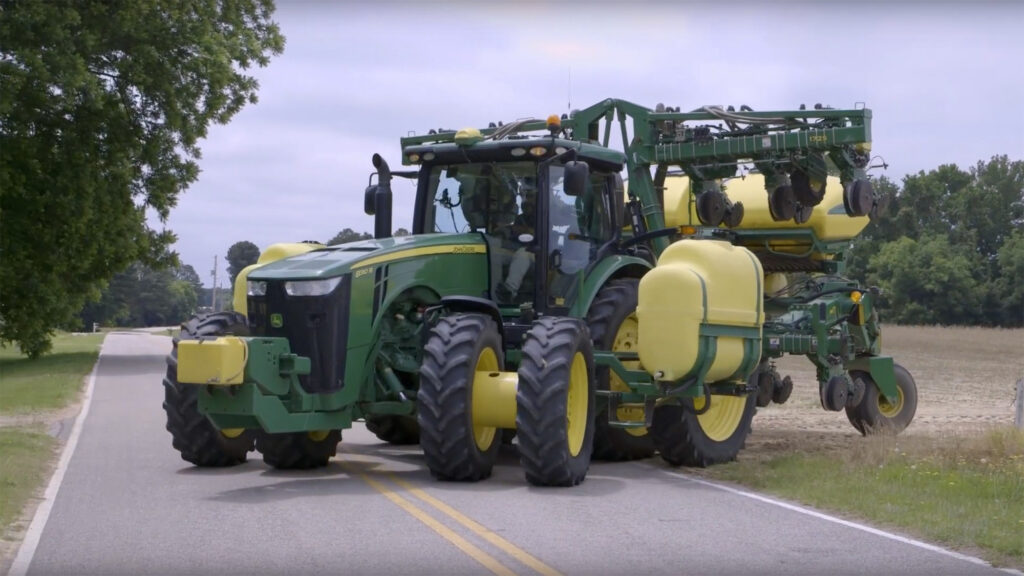
Share the Road with Farmers

Different Types of Farm Tours & How to Take One
Have you ever been on a farm tour? If so, what stood out for you? I will say I have been on a lot and they seem to range dramatically. What farmers call a farm tour may be really different than what some of us think of or want to go on…. it may also differ among the types of farms. So let’s get the lowdown on some of the different types of farm tours that can be given.
General reminder: right now we have a regularly changing landscape in travel so always call to check for times & dates the farm is open for visitors and whether tickets are available.
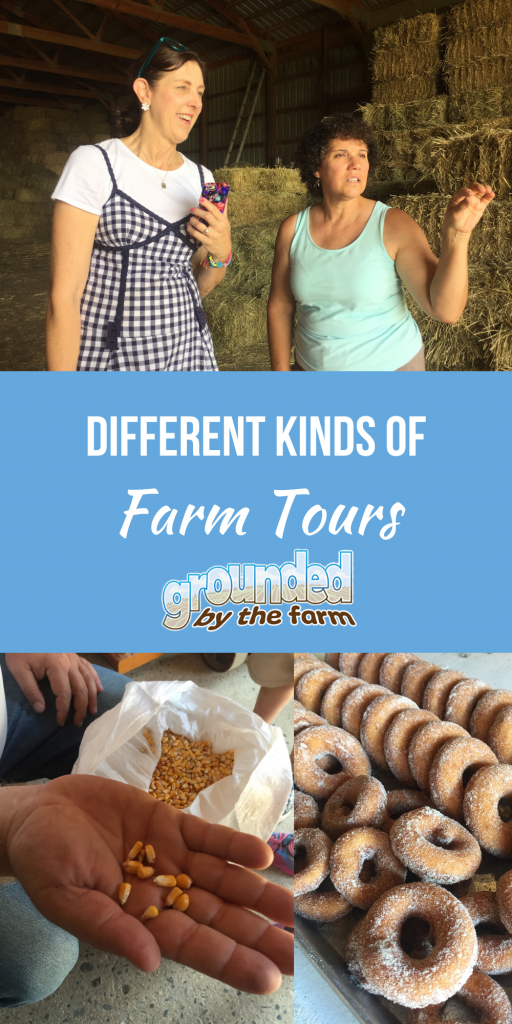
Farm Tours for Everyone
Seeing how our food is grown is so much fun for food lovers like me! And the number of farms that have opened their doors to their communities to come see what is happening has been consistently rising. And while I’d like to go see all of the farms, I understand it takes some dedicated time and effort and people want to be sure guests are safe, that the farm business continues.
Here are a couple of farms I’ve visited that host guests regularly.
Darden Farms
I’d be remiss if I didn’t remind you that Dee Dee Darden, who talked with us about Virginia ham several months ago, hosts a lot of guests on their farm outside of Smithfield, Virginia. They share lots of different animals and crops in fun ways and even take classrooms on hay rides and folks can get a peek into the smokehouse where hams hang if they are lucky!
Etsch Farms (NJ)
I recently saw some photos from a farm tour I took several bloggers (including Janis from MommyBlogExpert ) in the metro New York area on. It was a fantastic day on the farm with Caroline & Jim Etsch of Etsch Farms in Monroe Township, NJ . They tend to have small groups in as well as local sales of bakery items, etc.
The family does some agritourism on the farm alongside the hay & grain production they do. Just a short drive from the Holland Tunnel, they have a corn maze, run summer camp programs and I still dream of the apple cider slushies and doughnuts. They’ve done outdoor movies and some kiddie rides in the past — Caroline is always coming up with new ways to share information about plants, animals and farming.
Fair Oaks Farms (IN)
One of the farms that is set up to provide comprehensive tours is Fair Oaks Farms in northwestern Indiana. It has a large, modern dairy farm as well as pork and crops and they have a visitor’s center, a cafe and a restaurant as well as tours around the property to see how a bigger farm works. They have a lot of interactive displays, a playground and more!
My friend Natasha (who joined us for an episode on urban gardening ) took her family there on a home schooling trip and had a blast while learning lots! She’s got great photos of the pig adventure part of the day so you can see all the awesome on her blog. One of the pieces that has always gotten attention is the center where calves are born. It’s amazing to see a calf being born or even just as it tries to get its legs under itself.
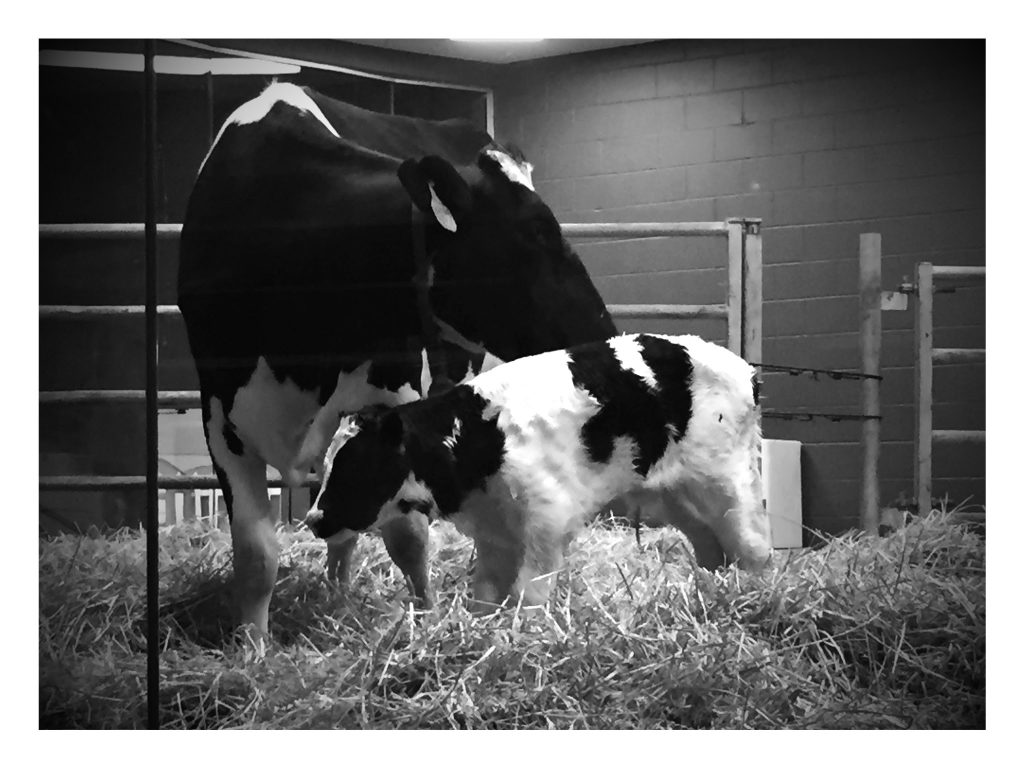
Virtual Farm Tours
As technology has grown, one way more farms have been able to open up to the public is virtually. With virtual tours, the safety of the guest and safety of the animals, etc much easier to do. And with covid-19, some in-person opportunities are harder for some people to get to right now.
But there are also in-depth farm tours that can be live or watched later too. I usually hear about them via Facebook event invites. This tour of a pig farm in virtual reality was put together by some friends. I love it! You can wear goggles or simply hold your phone up and the video will enable you to look in a full 360 degrees rather than simply straight ahead.
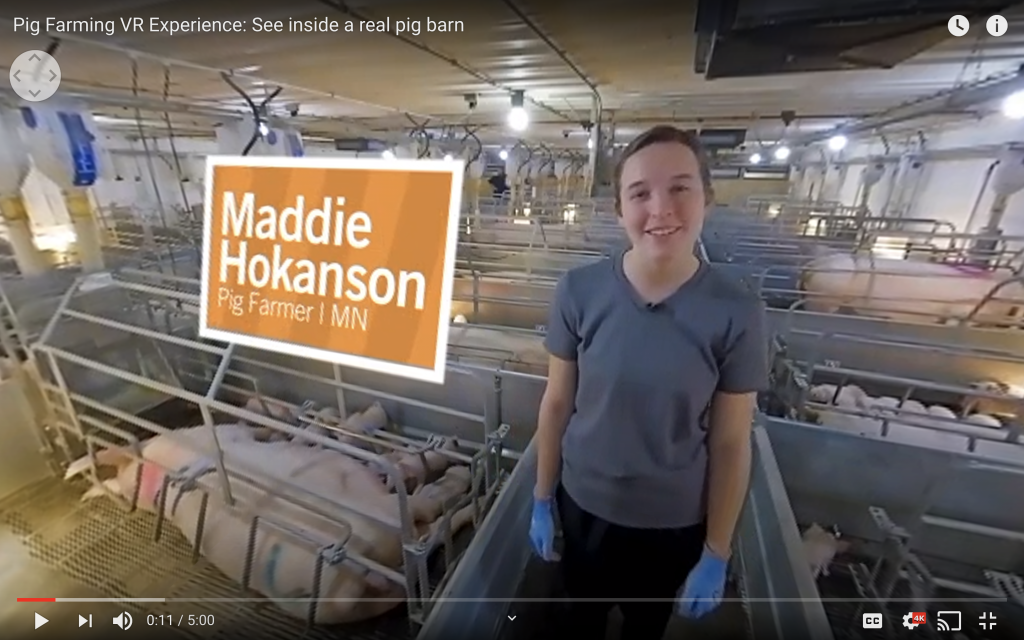
That one is a short 5 minutes but in this pig farm tour that Kansas Pork did for several schools, it’s a full class period of learning and conversation . That type of depth allows for some great explanations of how they get feed into bins and things as well as look inside the barns.

There are farmers who do a lot of social media posting showing people their farms regularly — if you have a specific kind of farm or geography you are interested in connecting on, pop that in the comments and I will find you a farmer who shares that if I can!
Finding Farm Tours Near You
In the recent Q&A episode, one of the questions was about how people can find farm tours near them. One of the simplest ways is to search google for your state’s department of agriculture website. There will be a lot of information that is clearly details farmers need, but there are also state run programs to connect residents to agriculture. They usually have a dedicated website as we discussed and it frequently has a list of local farms that do agritourism, special events, etc.
Farm Tours Farmers Usually Take
For farmers and others in agriculture, touring other farms is usually geared toward finding new products or practices that they may want to try out too. There is a lot of discussion about how a type of seed works on one type of soil or another, or about whether this practice reduces fuel use and what customers may prefer.
Really, they talk about all the things. Equipment like tractors and the weather differences are always huge.
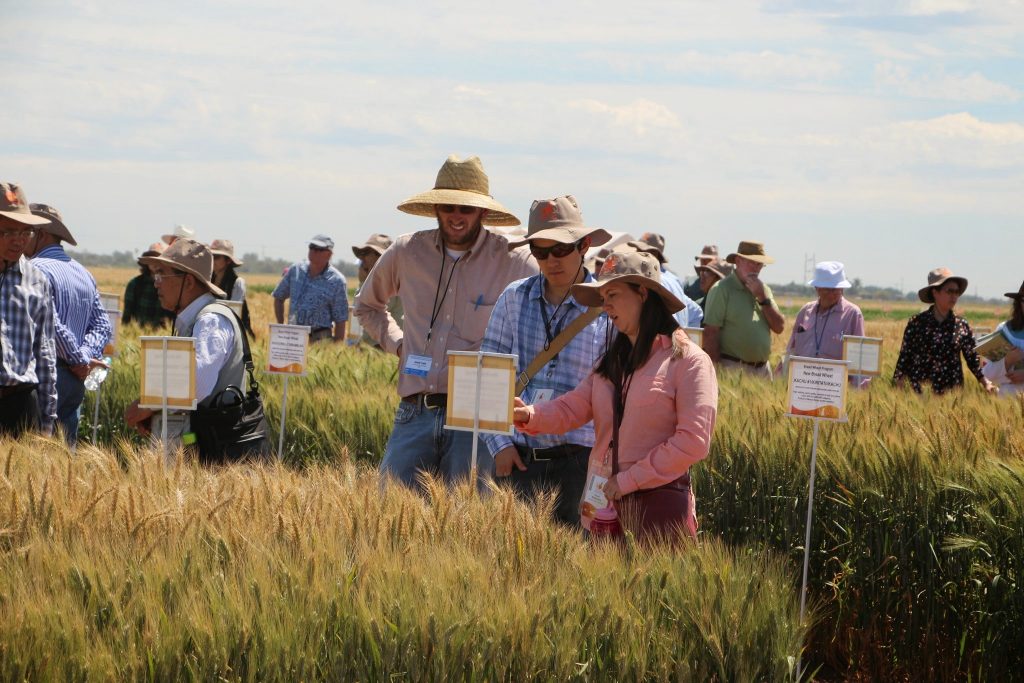
Wheat breeders from around the world take in a farm tour in Obregon, Mexico at CIMMYT
Most of the farm tours I have been on were for various crops and I got really used to doing tours of cotton & soybean fields . A few years ago I wrote a piece explaining why you may see a bunch of signs in a farm field along the highway. I still get excited about field days & farm tours even after going on hundreds of them. One is I love talking with people but I also always learn something.
I can’t lie, with the depth of interest and knowledge farmers have, I’ve been on a lot of farm tours that would bore my family to tears. Farmers work separately so often that the are some who will spend the whole day at a farm tour asking questions, some may arrive early and they may bring a vehicle full of people too! After years of being Grounded by the Farm, I’d say I’m more excited usually but 100 degrees and high humidity can temper my enthusiasm quickly.
Every vegetable farm tour I went on left to lots of new learnings and experiences.
One day I go to go out on a farm where they had planted more than two dozen spinach varieties! I had never even though about there being dozens of different spinach varieties. People asked about what is being seen with salad preferences with respect to color (how dark or bright the leaf is) and veining patterns (is it a deeply textured leaf or are veins more shallow). There was discussion about leaf size and shape. I won’t lie, I needed a spinach salad, spinach enchiladas, and all the things that week!

This year, more farmer tours are going virtual and that’s something that will be new for a lot of us. Kicking the dirt and seeing things close up…. well, I’m sure you can see why it is so popular. Most of us like to do it too!
- Categories: Farm Basics
- # farm tour
- # New Jersey
Leave a Reply Cancel Reply
Your email address will not be published. Required fields are marked *
Save my name, email, and website in this browser for the next time I comment.
This site uses Akismet to reduce spam. Learn how your comment data is processed .
3 comments on “ Different Types of Farm Tours & How to Take One ”
Good day ma’am,
I just love what am reading. I just ventured into taking farmers on farm tourism when the pandemic struck.
I so much love the virtual tour you talk about.
Please can I have you be my mentor on this line of business
As a small business owner myself, I’m a bit overloaded right now pivoting my business and doing paid consulting alongside the volunteer mentoring I am already committed to. I wish you the best. If you want to hire someone to assist you, I can ask friends who have more experience in that area.
Don't miss a post! Sign up to receive updates and new posts directly to your inbox!
You have successfully joined our subscriber list.
Meet Your Host

- Apple podcast
- Google podcast
- Amazon Music
- I Heart Radio
Farm Tours: The Unexpected Vacation You’ll Never Forget
When you think of your next vacation the idea of waking up to the soft sounds of animals eating and getting your hands dirty in the dirt may not come to mind right away….but it should! Visiting a farm, or even having a working farm vacation, is such an intense cultural and agricultural experience that really opens your eyes to a whole new world. Whether you’re looking to immerse yourself in a cattle farm for a week and learn the ins and outs of migrant cattle moving, or plant vegetables for an underprivileged area while staying in a yurt, you can learn a lot about yourself and the world when you experience a farm tour.
First off, you might be asking, what is a working farm vacation and a farm tour? A working farm vacation is a break from your normal everyday life and subjecting yourself to the peace (and hard work) of farm life. There are many families that open up their home and land to visitors who want to try their hand at farming for a short while. A small property or room on property will be your home-away-from-home, you’ll work the land, do chores, and really get to know the family in a unique one-on-one experience. It’s a change to learn about the impact that our culture has on the world as well as the importance of farming to our global community. A farm tour is usually something a bit shorter, possibly a full-day experience, where you learn about the land, the farm, the people and the farming impact on the world.
Best Time to Go on a Farm Stay or Farm Tour
What can you do on a farm stay or tour, you’ll change as a person during a farm stay or tour.
The amazing thing about farming – it happens all year long! In different seasons and different areas of the world, there are different trends in farming and opportunities for you to experience! Organic farms that produce plants and herbs have a season for sewing, a season for growing and a season of harvest – all of which can provide a unique, grounding and fascinating experience. Experience the methodical planning of planting season. Learn about the patience needed in the pruning and growing season. Understand firsthand the labor of love it is to experience the harvest; for without hard work often we can’t appreciate the ripe harvest (which is both true for our physical and emotional lives).
Animal farms literally have lives to maintain and every season you visit will highlight something new in your own soul as well as fascinating in the lives of these farmers. The spring season brings new birth with lots of babies being brought into the world. Summertime has challenging sweaty work that makes you tough and appreciative of the work these people put in day in and day out. Autumn brings a season of cooling and often animals have to “flip pasture” so they can enjoy fresh grass and food during the cooler months. Winter is a nesting season full of keeping all warm and protected and preparing for the next season of babies.
Each farm stay or tour offers something different and honestly you can find something for your comfort level. If you want to feed baby cows, clean out horse stalls, and gather fresh chicken eggs then there’s a traditional farm stay out there for you. Or maybe you want to be in a remote part of the mountains where you can meditate and find peace in the methodical planting of seeds. Farm stays in tours are offered all over the world, in many languages, and with many opportunities to get involved. Being hands-on with animals, cooking with your host family, cleaning, planting and sewing, cattle drives, being involved in the harvest… there are so many options out there for you to grow, learn and connect.
In a world that is constantly go-go-go and technology focused, there is something refreshing about stepping away from it all. There is a sense of nostalgia to a simpler time. A farm stay is a unique opportunity to get away from the normalcy of fast-paced tech-filled living and get back to nature. It’s a time for you to connect with your inner soul and nature which can be a very healing and purifying experience. There is a sense of grounding you will experience during your time on the farm. Whether it’s for a day or a week, the opportunity to get your hands dirty, connect with another human being on an emotional level, and understand our impact on Mother Earth is a truly humbling experience.
There are so many options for a farm stay or farm tour for your next vacation. All over the world there are farms that have opened their doors and arms to people from all different walks of life to experience life on a farm. The opportunity to connect with yourself and the world around you is a beautiful, healing, and cleansing experience you don’t get in many places in the world. There is a simple pure joy about getting back to nature and disconnecting from the bustling world, so we hope this inspires you to consider a farm stay or farm tour for your next memorable vacation.
- Farm Tours: What to Look for in a Unique Hawaiian Culinary Experience
- Hawaiian Vacation with Kids: Trends and Planning Guide
- Food Tours: A curated local experience
- Solo Vacation Trends and Safety Tips
- What is the best national park for jeep tours?
- What is the best national park for helicopter tours?
Open 7 days a week from 10am-5pm. Bus tours run at 11am, 1pm, and 3pm. Reservations recommended.
- Event Calendar
- Get Directions
- 717.394.6185
Farmhouse Tour
Visit our 1805 farmhouse and experience what life is like for the Amish community. This museum tour will explore all rooms of our farmhouse, once lived in by an Amish family. This historic farmhouse was the very first Amish tour in the United States.
Coming today? Tour tickets are available upon arrival, with no reservations required. If you have a group of 15 or more, please call.
Image 1 of 7
Image 2 of 7
Image 3 of 7
Image 4 of 7
Image 5 of 7
Image 6 of 7
Image 7 of 7
What’s Included in the Farmhouse tour?
- 30-minute guided house tour of our 1805 farmhouse
- Self-guided tour of our 15-acre farm (included with paid tour ticket)
- Visit to the Willow Lane One-Room School (included with paid tour ticket)
What You’ll See
Our tour guide will welcome you into our 1805 farmhouse, located on our farm property. As you walk through each room, you’ll learn about what it’s like to be Amish. You’ll learn about their religion, history, clothing, and homelife.
- You’ll see examples of Amish girl and boy clothing
- Common decorations inside of an Amish home
- Specialized kitchen appliances
The farmhouse is located on our property. It was onced lived in by an Amish family and we have converted it to be a museum. There are no Amish people living in this house today.
What You'll Do
Walk through each room while listening to our in-house tour guide. Have you ever wondered why the Amish use horse and buggies and the Amish ladies wear dresses? We will teach you everything you’ve ever wanted to know!
Example Farmhouse Itinerary
Approx time: 30 minutes Guided House Tour + Farm Visit
The following example itinerary is based on a Farmhouse tour starting at 11:45 a.m.
1. Arrival/Purchase Tickets Available All Day 10-6p.m.
Our farmhouse tours are scheduled every house, starting on the :45 of the hour. When you purchase your ticket, you will be given a tour time. There’s never any waiting. For example, if you purchase a ticket at 11:00 a.m. you can start with the self-guided farm tour before starting at 11:45 a.m.
2. House Tour 11:45- 12:30 p.m.
You will meet your tour guide inside the farmhouse. You’ll be seated inside the Amish church room and experience what it’s like to be Amish. Ask as many questions as you want!
4. Farm, Food, & Gift Shop Time 12:30pm – till closing time
Your paid tour ticket grants you access to enjoy our entire 15-acre farm located on our property at your leisure. Check out the one-room schoolhouse, see demonstrations by our resident artisans , and much more!
Thursdays-Saturdays the BBQ Barn is open with grilled chicken, ribs, sandwiches, soft pretzels and ice cream. Enjoy your picnic-style meal right on the farm.
Check out our event calendar for any special events happening during your visit.
We encourage you to arrive as early to visit the farm before your tours. Keep in mind our artisans leave at 5 p.m.
House Tour Schedule
Our house tour times change throughout the year. Here are the current tour times for this year.

Winter / Spring
March 18-May 26 10:45 a.m., 11:45, 12:45, 1:45, 2:45, 3:45
Spring / Summer
May 27 – September 3 9:45 a.m., 10:45, 11:45,12:45, 1:45, 2:45, 3:45, 4:45
Fall / Winter
September 4 – November 30 10:45, 11:45, 12:45, 1:45, 2:45, 3:45
December 1 – December 25 10:45 a.m., 11:45, 12:45, 1:45, 2:45, 3:45 p.m.
December 26 – December 31 10:45, 11:45,12:45, 1:45, 2:45, 3:45, 4:45
See What People Are Saying
We came here with 3 adults and 7 children. You start with a house tour. We were nervous about the tour with all the kids. Thankfully, everyone found the tour interesting and not overly long. After that, we were able to wander the outside. It was much better than we expected not only did they have sample buildings of how the Amish live. They also had animals and some fun things for the kids. ( you have to try the scooters). Worth every penny. Happy to say we were not rushed through the outside and were able to enjoy at our own pace.
Review from TripAdvisor : Ellen B.
Being in Lancaster without going to the Amish Farm and House is like going to Paris and not seeing the Eiffel Tower or going to Rome and not seeing the Coliseum. The rich history of the Amish life and contributions of this religious group is revealed at the Amish Farm and House. The relics, furnishings, clothing, buildings, and memorabilia come alive through the great stories and explanations of the guides and curators working at this site. If you are In Lancaster for any reason, treat yourself for an hour or so at the Amish Farm and House and feel yourself slip back in time and be among a small group of compassionate people that helped build our nation in a special way.
Review from TripAdvisor : JVPSP
Other Popular Tours
Guided farmhouse tour, classic bus tour, deluxe amish dinner & bus tour.

- Privacy Overview
- Strictly Necessary Cookies
This website uses cookies so that we can provide you with the best user experience possible. Cookie information is stored in your browser and performs functions such as recognising you when you return to our website and helping our team to understand which sections of the website you find most interesting and useful.
Strictly Necessary Cookie should be enabled at all times so that we can save your preferences for cookie settings.
If you disable this cookie, we will not be able to save your preferences. This means that every time you visit this website you will need to enable or disable cookies again.
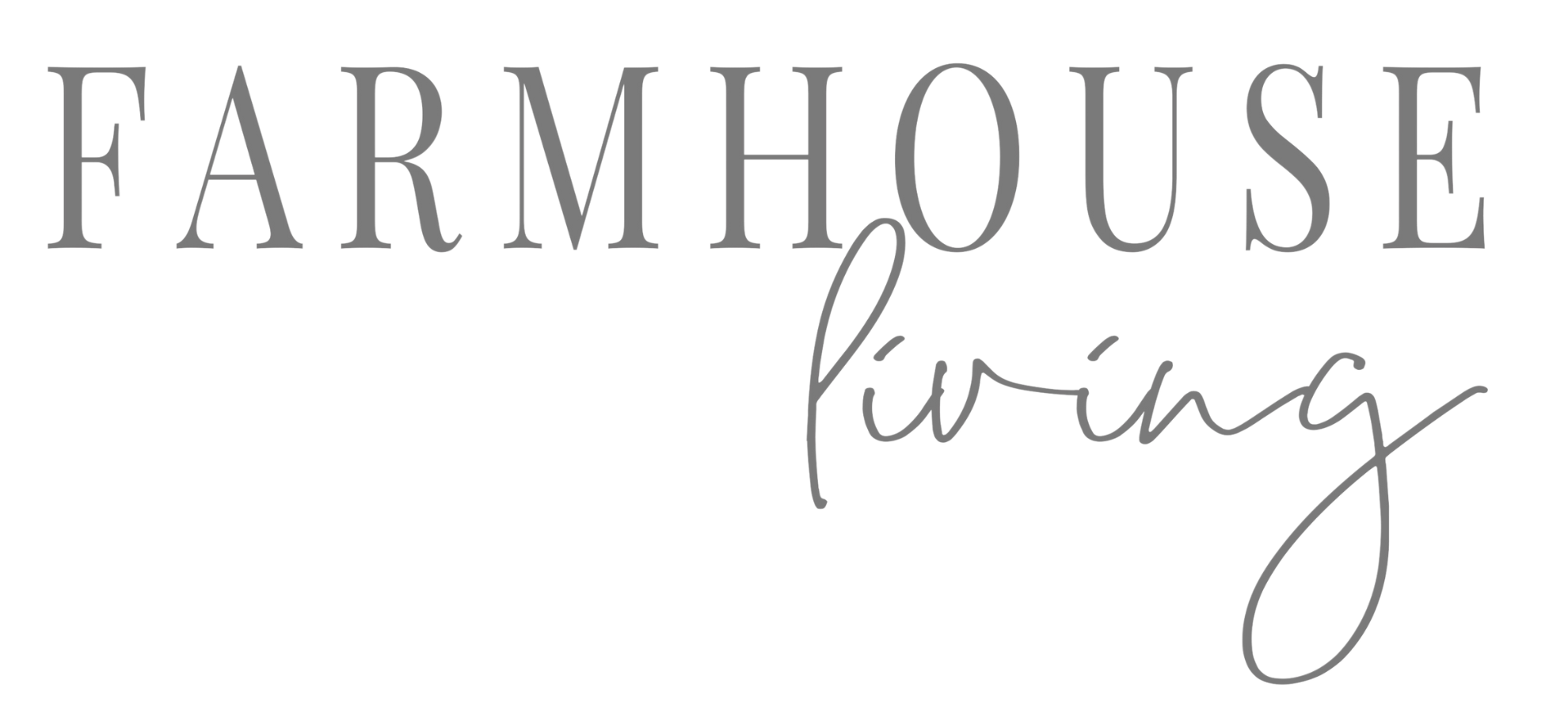
Thistlewood Farms Home Tour – 110 Year Old Farmhouse with Graceful Style
We’re back with another home tour and I’m thrilled to be sharing one so amazing. If you’re new to the Farmhouse Living blog, once a month mom and I share a home tour of another homebody that has tons of inspiration to give.
Today we’re sharing KariAnne’s of Thistlewood Farms 110-year-old farmhouse. KariAnne’s joy and passion are contagious. This home is her childhood home so she shares so many fun stories and sentiment in every space. You’re going to love this one.
SCROLL DOWN FOR VIDEO TOUR & SHOPPING LINKS👇🏻👇🏻👇🏻
Before you even walk in you’re drawn in. I knew it was going to be a cozy dream standing at the curb. The character of this old home is so welcoming with the mature trees and pretty landscaping. Isn’t this a dream??

LIVING ROOM
When you walk in you’re greeting by this beautiful living room. KariAnne called her style in this space colorful classic eclectic. I love this description because it didn’t really box her into any category. You see elements of traditional, glam, and even farmhouse in this space. Let this room be an example that you can mix all the styles you love .

KariAnne has fun pops of blue in her living. She shared in the video that she initially went completely neutral in this room and then she fell in love with a blue throw pillow at a yard sale. She continued to add blue accents including this gorgeous blue rug that brings the entire space together.
Something to note about this space is that all the larger pieces are neutral. If she ever wanted to change up her color scheme it would be very easy. If you love to switch things up add colorful accents that are easy to switch out and keep your investment pieces neutral.

SHOP THE LOOK
Dining room.
This dining room is AMAZING. It’s the antithesis of the living room with navy and white. The walls look like they have beautiful textured wallpaper, but this was a treatment that KariAnne’s sister added in high school when they lived there as kids. She said she took drywall mud and ran over it with a hair clip to create the fun texture. It’s painted Sherwin Williams Naval. The chandelier in this room is original to the home.
I love how KariAnne created this unique tablescape with dishes in an old dough bowl. I’ve never seen this before but I’m going to keep this idea in my back pocket.

The millwork on the stairs in the entry way is original to the house. It’s ornate and simple all at the same time. This is the type of character that makes an old home so special. The chandelier here is also original to the home.
She has a gallery wall of mix match mirrors going up the stairs. Some have frames and some do not, but they all look perfect together. They really draw your eye up.
All of the furniture pieces in this area were thrifted or passed down carrying such fun stories and adding even more character to this area.

This office is not only pretty, but it was so special to hear KariAnne talk about the memories of her dad giving her words of wisdom as a kid sitting at that exact desk. This makes me think twice about throwing out a piece that could potentially have a story and meaning one day. Do you have any furniture like this?

Right off the entry is the beautiful blue bathroom. The color is called Let It Rain by Sherwin Williams. Although this floor tile is super popular right now, this is not updated floor! It was the exact tile from KariAnne’s childhood. You also see the original heater on the wall.

When KariAnne first purchased this home back from the couple her mom sold it to, she removed the wall that closed in this kitchen to create a bulter’s pantry. The glass cabinets on the wall were actually salvaged from the butler’s pantry adding so much character to this freshly renovated kitchen. Her island adds contrast painted Sherwin Wiliams Peppercorn. This color looks amazing with the clear hardware she chose. It has a fun victorian feel.
One thing I loved about her kitchen is that everything was on display. Even the functional daily ware like silverware. She says she likes to keep it all to where she can see it so everything gets it’s full use. I really love that thought. It’s better to use a piece than to shove it in a cabinet and forget you have it.

KariAnne has several fun DIYs in her kitchen. One of them is this plate rack on the wall. It’s a simple way to add character and functional storage to your kitchen. She has a full DIY tutorial on her blog here .
Another DIY was the cute wooden letters she has mounted on the wall that say FARM. She shared such a sweet story with these letters. Her brother and his wife were looking to adopt but didn’t have the finances since adoption is very expensive. KariAnne posted these letters on her blog as a DIY and at the bottom of the post she shared a link to his Etsy shop for them to purchase if they didn’t have interest in DIYing. They sold $40k in letters allowing her sweet niece Mia Kate to be adopted. I want home accents with that type of sentiment in my home!

BUTLERS PANTRY & LAUNDRY ROOM
Sometimes it’s the smaller spaces that really pack a punch when it comes to design. This laundry room/butler’s pantry does quite that. KariAnne’s laundry is on the left side styled perfectly, but also ready for all the practical use. On the ride side, there’s a butler’s pantry with a fun collection of white dishes, a coffee bar, and her trash can hidden behind a sliding door. You can see more of this space in action on the video tour .

FAMILY ROOM
Now to the family room. This area is so cozy and I can’t believe it was a garage conversion. I never would have known.
In the video tour, KariAnne was sharing that her intent in the home is for it to be lived in. I loved when she said, “I don’t want this to be a museum…If someone wants to sit down and eat a chocolate cake on the slipcovered couch, let’s go!” Now that’s what’s how is all about.
You feel that in this room. It has multiple focal points that draw your eye in. In the back, she has a game table with two beautiful antique chairs that she purchased at a yard sale for $20! She has so many fun yard sale finds in her home.
She has built-ins on the wall where her TV is. The wall sconces dress up this area and add a modern touch.

Y’all this home tour was such a blast. I hope it inspired you as much as it inspired us. KariAnne made me want to head to a yard sale or a thift store and apply dry wall mud with a comb onto a wall in my house 😂Not only is she so talented at creating home, but she’s just wonderful to be around. Thank you KariAnne for sharing your gorgeous home with us. We’re officially real life BFF’s.
If you want more inspiration from KariAnn I’ve linked all her social media and blog below. She has so many fun ideas and projects that she shares every week. You’re going to love it.
FIND KARIANNE ONLINE FOR MORE INSPIRATION
Instagram – @thistlewood
Blog – www.thistlewoodfarms.com
Youtube – www.youtube.com/c/ThistleWood
Pinterest – www.pinterest.com/thistlewoodfarm/
You can view more home tours by following the link here. If you are interested in being featured on the Farmhouse Living blog with a home tour you can reach out here ! We’d love to get to know you.
📷Photos by our amazing photographer: Charlee Tabor Photography .

PIN FOR LATER

Similar Posts

Modern Tudor Home Tour with Renovation Before & Afters
This home tour is filled with shocking before-and-afters, stunning character, and even a CHAPEL….

Luxury Modern Classic New Build Home Tour: Bright, Airy, and Pops of Pastel in Rockwall, TX
We’re absolutely thrilled to share this home tour with you. What you’re about to…

TX Sized Home Tour – Farmhouse Christmas
If you love shiplap as much as we do then you’ll love Megan of TXSizedHome house tour! Megan of TXSizedHome’s house is so thoughtfully designed and unique to her family.

New Build Modern Farmhouse Home Tour with Jessica of The Old Barn
Today we’re share Jessica of The Old Barn’s new build modern farmhouse. Jessica and her husband built their home in 2019 and she designed the floor plan herself.

Treasure Hunted Home Tour: Mixing Vintage Finds in a Modern Home
Today I’m teaming up with two other blogger friends to bring you a Treasure Hunted Home Tour. All of us will be sharing our favorite thrifted, vintage and secondhand finds that add character to our homes. You’ll also find tips to treasure hunt for your own home.
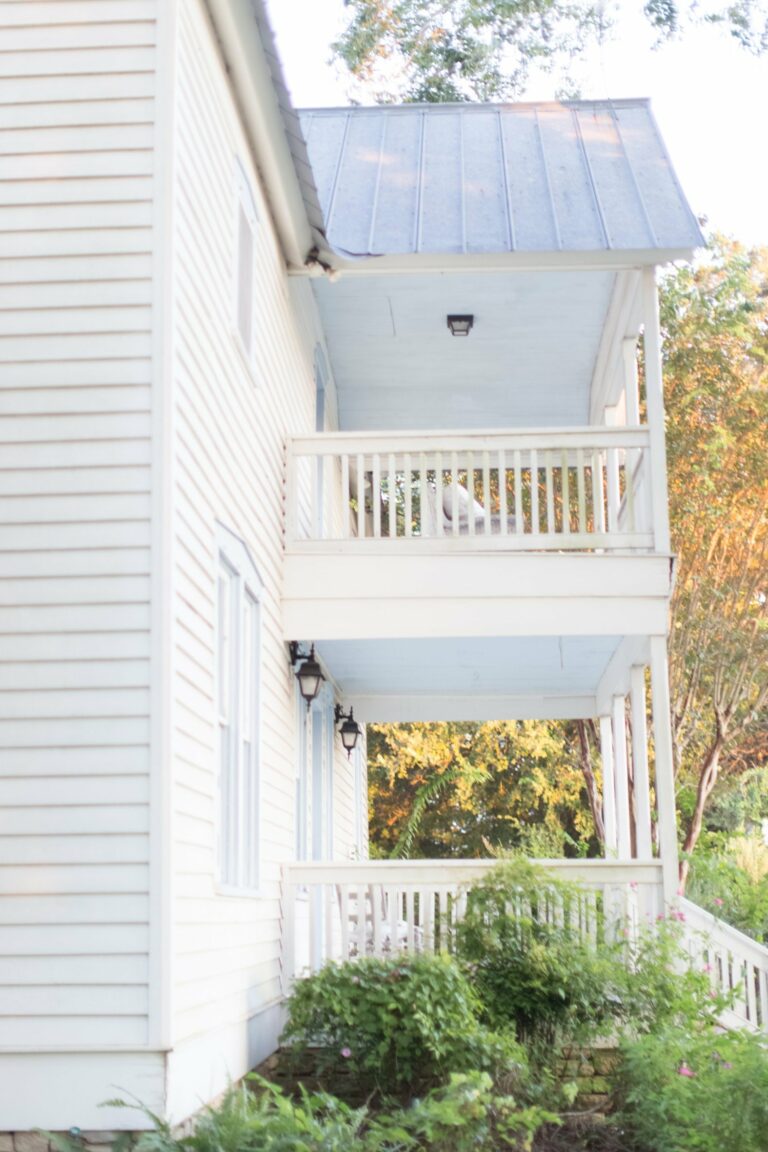
Our Visit to the Prairie by Rachel Ashwell
On a recent trip to Round Top we were guests of The Prairie. And we couldn’t have been more thankful. While this trip was in the fall, Texas heat, along with extreme humidity made shopping almost unbearable! So time spent in the mid 1800’s prairie farmhouse updated with modern amenities like A/C was a dream.
Leave a Reply Cancel reply
Your email address will not be published. Required fields are marked *
Save my name, email, and website in this browser for the next time I comment.
- Agri-Commodities
- Asean Economic Community
- Banking & Finance
- Entrepreneur
- Executive Views
- Export Unlimited
- Harvard Management Update
- Monday Morning
- Mutual Funds
- Stock Market Outlook
- The Integrity Initiative
- Editorial cartoon
- Design&Space
- Digital Life
- 360° Review
- Biodiversity
- Environment
- Envoys & Expats
- Health & Fitness
- Mission: PHL
- Perspective
- Today in History
- Tony&Nick
- When I Was 25
- Wine & Dine
- Live & In Quarantine
- Bulletin Board
- Public Service
- The Broader Look
Today’s front page, Tuesday, April 9, 2024

The rising industry of Farm Tourism in the Philippines
- BusinessMirror
- August 30, 2022
- 4 minute read
Table of Contents Hide
What is farm tourism, the benefits of farm tourism, farm tourism in the philippines, answering why farm tourism is important: agriculture and tourism.
Agriculture and tourism play a huge role for our country, which is why farm tourism in the Philippines has begun booming. Dubbed as the country’s sunrise industry, farm tourism is a logical and refreshing new addition to the list of projects that generate additional income for Filipino farmers. It has also perfectly catered to the rising interest of many people to partake in the production of healthy food with their families.
By combining agriculture and tourism, the food farming industry has slowly opened more inclusive and sustainable opportunities for not only farmers, but institutions nationwide. Today, as food farm tourism continues to become a growing sub-sector of tourism, legislators and experts alike have turned their heads to develop the industry. Still, not everyone is familiar with farm tourism and its benefits.
In this article, we talk about farm tourism in the Philippines–from its importance to the many activities you can try when visiting these tourist farms.
Farm tourism is the business of attracting visitors to farm areas generally for educational and recreational purposes while encouraging economic activities that can provide both the farm and community additional income. The most famous example of farm tourism in the Philippines is perhaps the La Trinidad Strawberry Farm in Benguet. However, as a rising industry, more and more farms have started opening their gates to tourists.
There are many farm tourism activities that can be experienced when visiting rural farms. Children and adults alike can feed animals, collect eggs, do nature-based arts and crafts, try horseback riding, hike, eat meals with freshly cut vegetables, pick fruits and harvest vegetables, try new varieties of fruit juice or wine, create community-based products, or even stay overnight in the area. The activities vary, depending on the farm that is visited.
These quaint farms offer a charming change of pace from the hustle and bustle of urban living. Make no mistake–these farms are absolutely gorgeous still! Some can even be used as an intimate wedding venue for the introverted couple.
Sen. Cynthia A. Villar, chairman of the Senate Committee on Agriculture and Food, views farm tourism as one of the Philippines’ sunshine industries that can be pursued because of the agricultural nature of our economy.
She noted that farmers and fishermen need to diversify and supplement their agricultural incomes, and farm tourism is one creative way to achieve this goal. As a show of her support and enthusiasm for such projects, Villar continues to work on vital legislation and amendments to existing laws to complement this growing subsector of the tourism industry. She has even launched a farm tourism book to provide more information about the industry. It would seem that farmers somehow share this view as many farmers-turned-farm tourism operators reported that they were earning from this newfound activity more than from their usual harvest during a Senate hearing.
International School of Sustainable Tourism (ISST) President and Project Director Dr. Mina Gabor also supports the industry, stating that farm tourism camps focus on low-impact travel and empower local communities socially and economically.
“Farm tourism attracts visitors and travelers to farm areas, generally for educational and recreational purposes that encourage economic activity to provide farm and community income,” she said of the benefits of farm tourism.
Aside from the economic impact of farm sites, farm tourism sites also help promote tourism and products of the area, especially those produced and manufactured by the rural industries. This is a common practice worldwide. In fact, some of the famous tourist spots in Europe and the US are farms.
In Costa Rica, a famous coffee plantation has eventually put up one of the world’s best ecolodges where you can stay and wake up the morning after to visit the plantation and try your hand in picking coffee berries. It also has a wonderful restaurant that serves its famous varieties of coffee, sells soaps made from coffee, and other farm products.
In Italy you can rent a cottage situated in the middle of the farm. If you want to cook your own meal, it can provide the ingredients, like fruits and vegetables, that you can pick just outside your doorstep.
A common factor among these farms, no matter where they are located, is that many jobs and revenues generated for the community are sourced from this activity.
Farm tourism has spread nationwide and is slowly becoming a steady source of income and development. It is no longer confined to the usual tourist spots, but even in rural areas. Of course, farm tourism in Nueva Ecija and other agricultural regions are flourishing.
There are around 100 or more accredited and nonaccredited farm-tourism sites in the country, ranging from micro, small, medium and large sizes. Some of the most successful tourist farms, also called farm camps, in the country include: Sunflower Farms in Ligao City, Albay province; Rapha Valley in Don Salvador Benedicto town, Negros Occidental province; Dragon Fruit Farm in Burgos municipality, Ilocos Norte province; Dasoland in Dasol town, Pangasinan province; and the Disneyworld of Farming Systems of the Mindanao Baptist Rural Life Center Foundation Inc. in Bansalan municipality, Davao del Sur province. To date, there are still some developers and small businesses owners who are converting their old farms into farm camps as well.
Aside from Sen. Villar’s initiatives, President Aquino also signed Republic Act 10816, or the Farm Tourism Development Act of 2016. Under the new law, a Farm Tourism Development Board shall be established to formulate plans and programs for the development and promotion of farm tourism in the country and shall set the overall direction for the implementation of the Farm Tourism Strategic Action Plan. At present, the current administration has expressed a desire to focus on both agriculture and tourism.
It’s no secret that rural economic conditions aren’t the best. Farmers and fishermen, more importantly, have very small earnings. Tourist farms and farm camps provide a creative way for Filipino farmers, fishermen, and agricultural workers to earn more without upending their daily routine and jobs.
The rising industry is still that–rising. However, with a little push and more education, farm tourism can be the answer to economic and cultural development in rural sectors. Time and effort will only tell the end results.
Feed a furriend in need during Pedigree & Whiskas Super Brand Day on Shopee
The history behind the problems of the metro manila film festival, unemployed filipinos less than 2m in feb ’24 – psa.
- Cai U. Ordinario
- April 11, 2024

Debt instruments spur 89.9% rise in January FDI

Marcos flies to US; regional peace, industries top agenda
- Samuel Medenilla
Citing timing, BSP treads slowly on RRR cut

PBBM: Traffic-busting plan focuses on mass transit

Recto: PPP, ODA being eyed for Mindanao rail funding
- Reine Juvierre Alberto
SC: CJHDEVCO should vacate leased portion of Camp John Hay
- Joel R. San Juan

DepEd wants to clarify school schedule revert
- Claudeth Mocon-Ciriaco

Asian trade in goods seen to grow despite conflicts
- Andrea E. San Juan

Think long term, Bautista tells transport gripers
- Lorenz S. Marasigan

Villar honors San Ezekiel Moreno on his birthday through music
Don’t allow gcta for rape,heinous crime cons–solon.
- Jovee Marie N. de la Cruz
Makati Police seizes P3.5M worth of shabu in 1st quarter

Taiwan firm lauded for humanitarian deeds
- April 10, 2024

DMW: OFWs injured in Taiwan quake now 15

Plebiscite for SGA in BARMM set April 13
Budget gap to narrow to 5.5% of gdp–analyst, bucor: 46 muslim convicts freed since ramadan began.

MB ‘powder’ to stay ‘dry’ on fluid global picture
Trade disruptions from red sea attacks impact u.s. firms, leave a reply cancel reply.
Your email address will not be published. Required fields are marked *
This site uses Akismet to reduce spam. Learn how your comment data is processed .
Input your search keywords and press Enter.
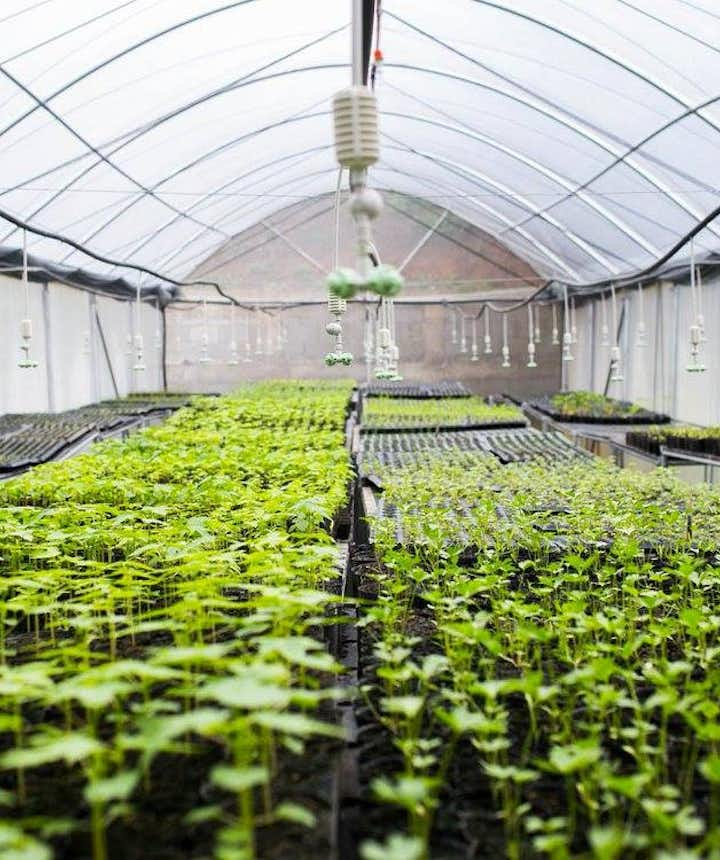
10 Best Destinations for Farm Tours in the Philippines

Orchard Valley
Ephrathah farm, damires hills tierra verde farm resort, 9. puerto princesa.
- Yamang Bukid
Sheridan Organic Farm
- Flor’s Garden and Nature Haven Inc.
Domingo Permafarms
Palaya farm.
- 7. Cordillera
- La Trinidad strawberry and lettuce farms
Northern Blossom Flower Farm
Benguet coffee farms, malagos garden resort and other cacao farms, sul orchid farm, bemwa strawberry farm.
- 5. Pangasinan
Our Farm Republic
Pacific farms - salt making farm.
- 4. Batangas
Kahariam Farms
Milea bee farm.
- Taal Maranan's Farmville Inc.
Gorgeous Farm
- Chad’s Nature Farm
Moca Family Farm
3. la union, rocapor farm, lomboy farms, bungol farm, happy house farm, gourmet farms.
- Yoki's Farm
Nurture Farmacy (Nurture Wellness Village)
The coffee farmhouse.
- Teofely's Nature Farm, Inc
Terra Verde Ecofarm and Resort
Costales nature farms, holy carabao holistic farms, forest wood garden, gintong bukid farm and leisure.
- Ato Belen’s Farm
Graco Farms
Alaminos goat farm.
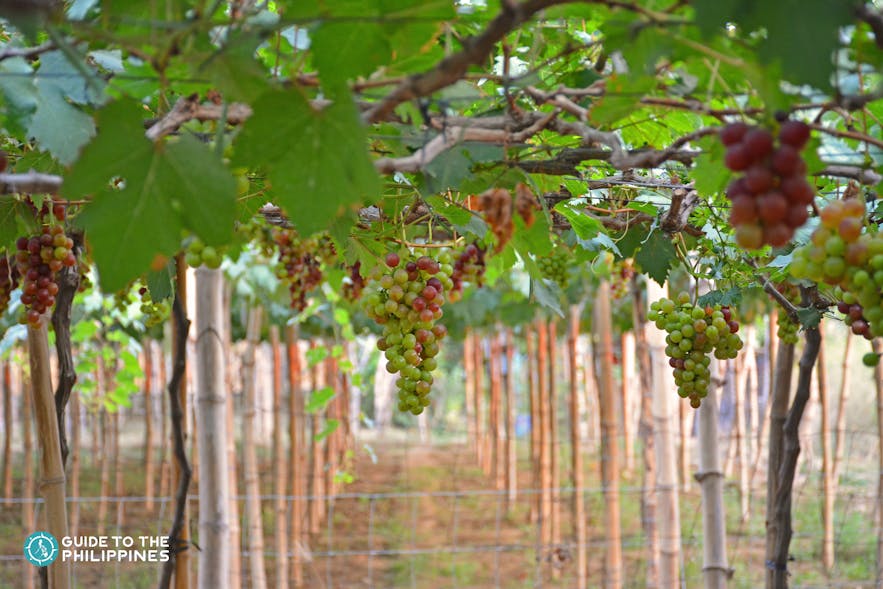
Travelers love visiting the Philippines for its tropical weather, virgin islands, and gorgeous beaches . But there’s another way to appreciate the county’s natural beauty and immerse in a more meaningful travel experience, and this is through agri-tourism.
Agri-tourism is centered on agricultural-based activities to attract travelers to farms and ranches. It’s meant to be educational, engaging, not to mention a more sustainable revenue source for farmers and local communities.
See our popular Farm Tours
Bohol countryside tour with loboc river cruise lunch & panglao island tour, tagaytay palace in the sky taal view & farms shared day tour with lunch & transfers from manila, guimaras top attractions & island hopping tour with lunch & transfers from iloilo city.
In recent years, the Philippines has become a top agritourism destination. Because of its thriving agricultural sector, the country is already home to many successful farms and plantations. Many of these properties welcome visitors and offer them farm tours , lectures, farming activities, and dining experiences in their farm stay resort
- Check out the best farm resorts & stays in the Philippines
- Read our article on travel insurance in the Philippines
The country’s brand of agri-tourism lets you experience the quintessential Filipino hospitality and rich farming heritage. You will be able to enjoy a vast collection of flora and fauna, get a glimpse of Filipino farm life, and get to know the people who work hard to feed the country.
To help start your Filipino agri-tourism adventure, here is a list of the best farm tour destinations in the Philippines:
10. Iloilo
Iloilo is one of the prominent provinces in the Visayas region of the Philippines. This province attracts many visitors because of its cultural and historical landmarks, parks, beautiful islands, and culinary heritage.
See our popular Iloilo Tours and Activities
Iloilo islas de gigantes island hopping tour with lunch, iloilo city to or from boracay caticlan jetty port | iloilo to boracay transfers.
Iloilo’s collection of agri-tourism sites is another reason to visit it. Some of the places that will complete your Iloilo farm tour include:

Located in San Joaquin Municipality, Garin Farm is no ordinary farm, as it’s also a place of leisure and religion, being the home of the Pilgrimage Hill.
At the heart of Garin Farm tours is the sharing of agricultural practices that contributed to the farm’s success. Other activities to enjoy during your visit include vegetable picking, kayaking, fishing, and dining at their very own farm-to-table restaurant.
See our popular Garin Farm Tours
Iloilo city top heritage attractions & garin farm day tour with transfers, iloilo tour to garin farm, san joaquin church, guimbal church with lunch & transfers from city.
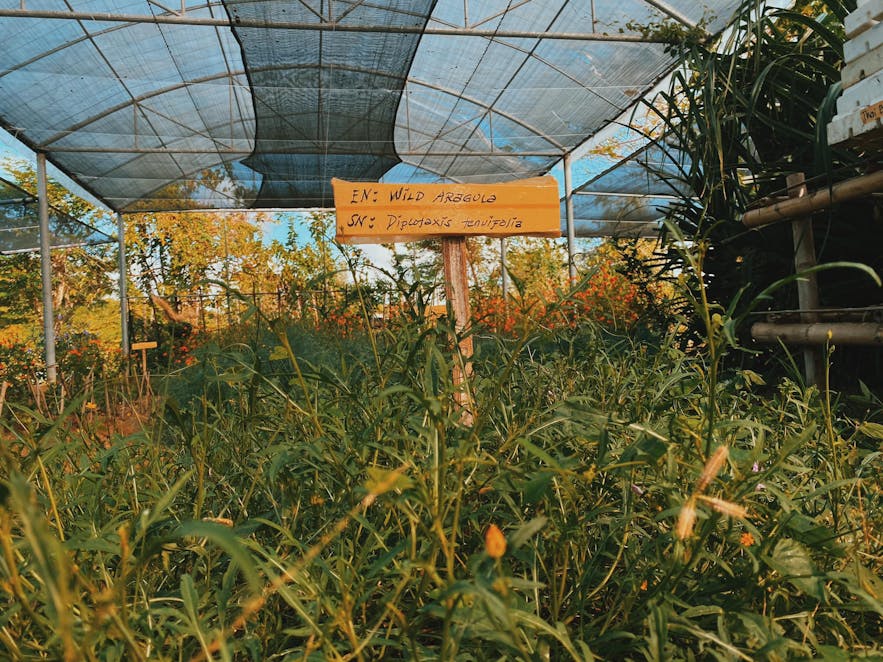
Orchard Valley is an organic farm in Pavia, Iloilo and extends to 33 hectares. This farm is known for thousands of malunggay trees.
The farm uses organic means to grow healthy trees. The leaves are then used to feed the cattle and pigs managed by the farm. Malunggay leaves are highly valued for their nutrients.
Orchard Valley also grows lettuce, water spinach, and various herbs sold in supermarkets.
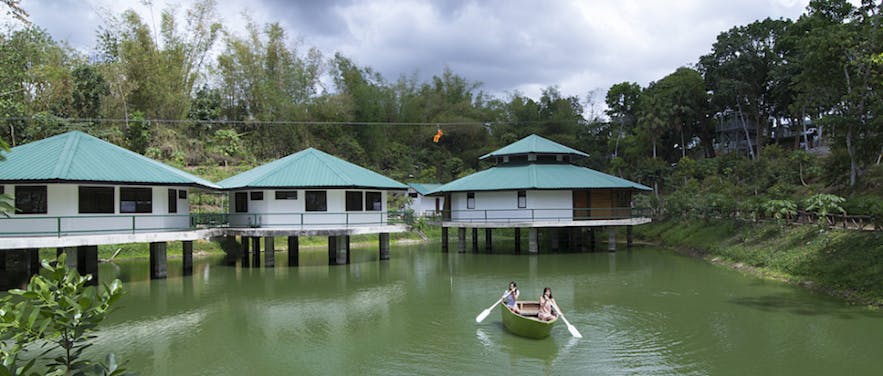
This 9-hectare farm is situated at Barangay Sariri, Badiangan. Ephrathah aims to operate a natural farm that uses zero chemicals and fertilizers.
Ephrathah aims to inspire visitors to appreciate the natural lifestyle. The farm is equipped with facilities like a zipline, rappelling site, ATVs, boats, and function halls.
Aside from growing produce like dragon fruit, papaya, and golden cherry tomatoes, the farm is also involved in aquaculture, producing species like pangasius, tilapias and kois.

Established in 2010, this huge 45-hectare farm is located in Barangay Damires, Janiuay. The farm is made up of two sections; the first one is a 16-hectare farm resort that welcomes day-trippers. The other 29 hectares is made of forest and crop plantations.
The Damires Hills’ farm experience lets you enjoy a gorgeous landscape. Some of its facilities include swimming pools, a zipline, canopy walk, and a 270-meter long hanging bridge.
Puerto Princesa is the capital of Palawan province and the Philippines’ westernmost city. It is the well-known gateway to El Nido , which is the highlight of Palawan tours . However, the city and its immediate surroundings also have plenty to offer!
Puerto Princesa tours usually showcase not only city attractions but also nearby forests, mountains, and coves. It's most known for the UNESCO World Heritage Site and New7Wonders of Nature, Underground River , and Honda Bay island hopping .
See our popular Puerto Princesa Tours and Activities
Shared puerto princesa underground river tour in palawan with lunch & hotel transfers, private puerto princesa airport palawan to or from any puerto princesa city hotel transfer service, palawan puerto princesa honda bay island hopping tour with lunch | starfish, luli, & cowrie islands.
Aside from natural wonders and beaches and islands, add another dimension to your visit to Puerto Princesa by checking out its most notable farms:
Yamang Bukid
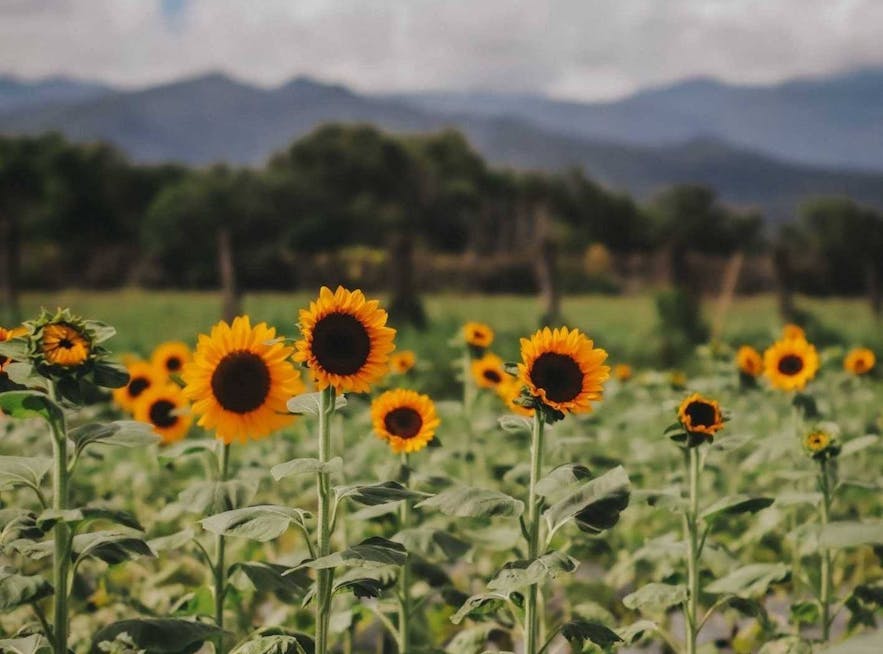
Yamang Bukid started out as a small tea business in Baguio City. It has gradually expanded to Barangay Bacungan Puerto Princesa, occupying 20 hectares of land and employing over 300 farmers.
Today, Yamang Bukid tours are quite popular among Puerto Princesa visitors. The farm’s most famous product is turmeric tea but it also grows papaya, strawberries, sunflowers, and other medicinal plants.
- Read our article about tea in the Philippines
The place is known for its serene environment despite being close to the city center. So if you need a break from the busy metro, be sure to check out Yamang Bukid.

If you’re looking for a relaxing farm stay in Puerto Princesa, Sheridan Organic Farm is the place to be.
Situated in Cabayugan, Puerto Princesa, Sheridan this farm is conveniently close to two other very popular tourist attractions: the Underground River and Sabang Beach.
Sheridan is not just a farm but an eco-friendly village that has its own accommodation facilities. Here, you can relax and learn more about the science behind farming in a peaceful, rustic, and green environment.
8. Rizal
Rizal Province is located in the Calabarzon region of Luzon and is named after the national hero Jose Rizal.
Rizal is a historical place with a good number of museums and historical places to explore. Despite its proximity to Metro Manila , Rizal is still blessed with lush greenery and rural landscapes.
- Check out our article on the best private resorts near Manila
Thus, it’s not surprising that visits to farms and natural attractions are usually the highlight of Rizal tours .
See our popular Rizal Tours and Activities
Scenic 2-day treasure mountain rizal camping package with daranak falls side trip & transfers, rizal treasure mountain day pass with breakfast, obstacle course, giant seesaw & bosay falls trek, breathtaking 2-day treasure mountain rizal camping package with breakfast.
Here are some of the great farms to visit in Rizal:
Flor’s Garden and Nature Haven Inc.

Flor’s Garden sits on a 5 hectare of land in Antipolo and is an advent promoter of sustainable farming.
Flor’s owns an extensive garden that houses a wide collection of flora and fauna. While here, you will learn the basics of farming and growing medicinal plants and their uses.
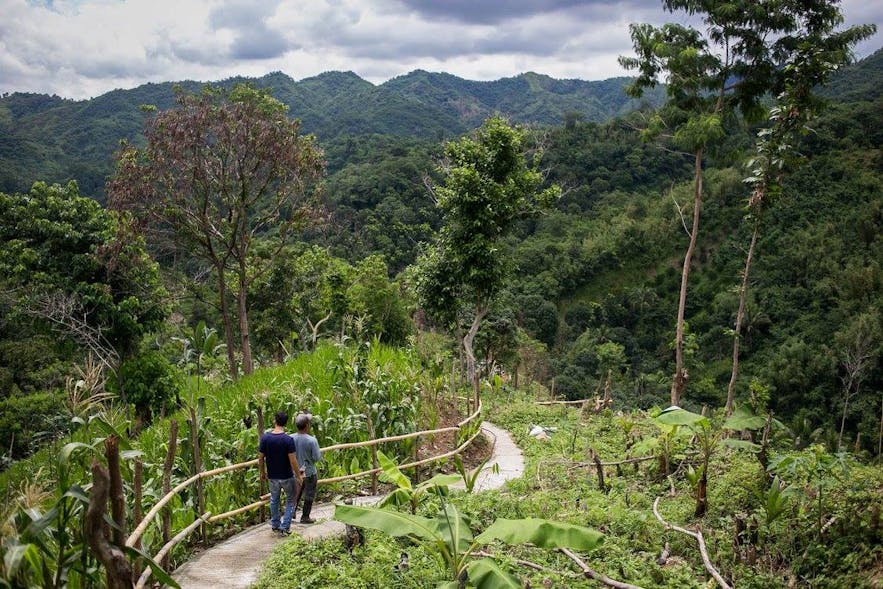
When it comes to farming, the family-run Domingo Permafarms in Barangay San Jose, Antipolo City, follows the Permaculture Design principles.
These principles, which you will learn during your visit, focus on sustainable agriculture, caring not only for crops but also for the farmers and the ecosystems.
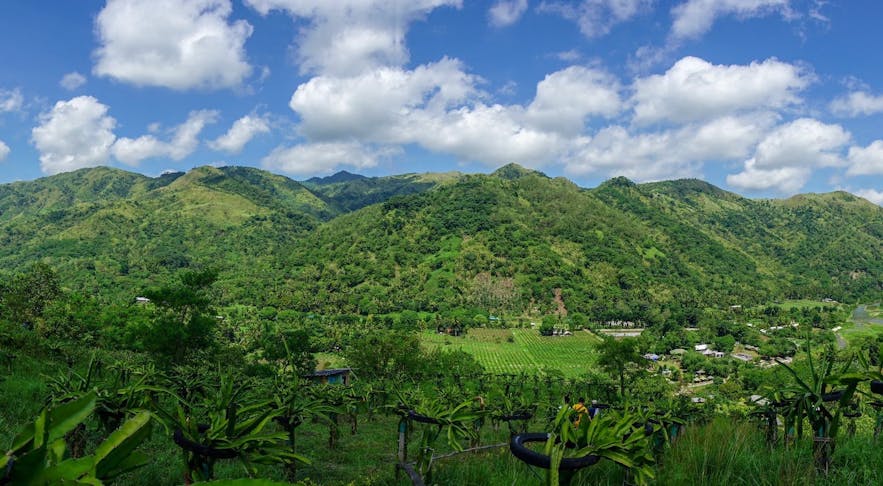
As a farm, Palaya easily stands out because it is currently the biggest dragon fruit plantation in the country. It is also the biggest producer and supplier of this wonderful tropical fruit.
Located in Tanay, Rizal, Palaya has more than 36,000 dragon fruits planted together with other varieties of vegetables. Your visit to Palaya Farm will be about growing dragon fruits sustainably as well as exploring the subject of natural farming and crop care.
7. Cordillera
Before agricultural tourism was a thing, tourists were already flocking to Cordillera for its outstanding farms and natural attractions. This region in the northern part of Luzon island is home to the iconic Banaue Rice Terraces and the popular Baguio City .
Many consider Cordillera as the pioneer site of agri-tourism in the country. It consists of six provinces, which are Abra, Apayao, Benguet, Kalinga, Mountain Province, and Ifugao.
Aside from doing Baguio tours , complete your Cordillera experience by visiting some of the region’s outstanding farms.
See our popular Baguio Tours and Activities
Baguio city shared cultural & outdoor tour with lunch & snack | mines view park, tam-awan village, atok gardens day tour with transfers from baguio | northern blossom, sakura park & tayao gardens, baguio top cultural & heritage attractions tour with lunch & transfers, la trinidad strawberry and lettuce farms .
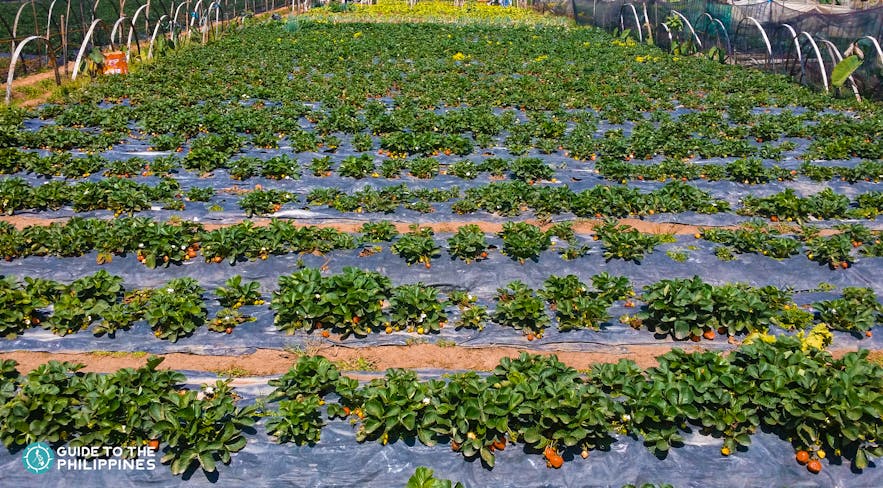
The La Trinidad strawberry farm is nestled in Benguet’s La Trinidad Valley. The farmland is only about 6 kilometers from the capital Baguio City, making it a convenient site to visit.
The farm’s main produce is strawberries, but the farmers have expanded to growing other vegetables like romaine lettuce.
Often called Strawberry Farm, this 80-hectare site is actually a set of farms owned by the Benguet State University (BSU). To explore this area, you may join one of the strawberry farm tours for La Trinidad.
See our popular Strawberry Farm Tours
Baguio shared strawberry picking & city tour with transfers from manila.
Just about 12 kilometers from Baguio City, in Atok, Benguet, lies the Northern Blossom Flower Farm. The farm spreads to two hectares and has become quite popular among domestic tourists.
A tour at Northern Blossoms showcases the property’s impressive collection of flora including the beautiful snapdragons and the edible cabbage roses, which originated from Japan. You can also choose to buy freshly picked flowers from the farm as souvenirs! Cosmic farm
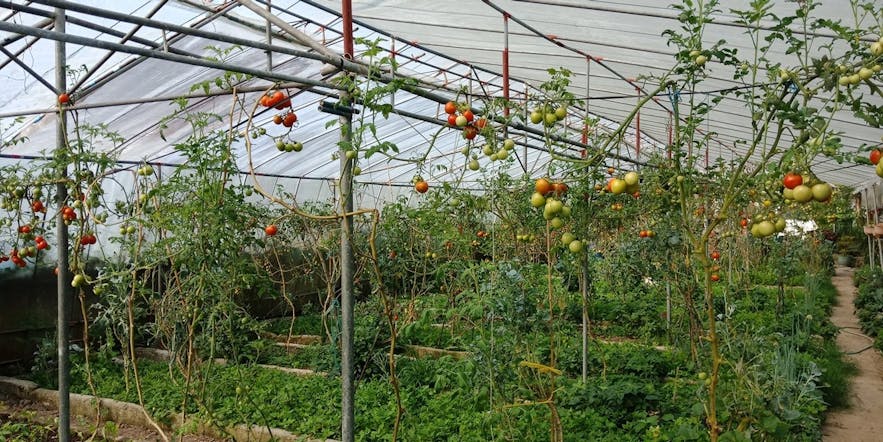
Cosmic farm prides itself as a prime producer of healthy 100 percent organic produce. Located in Caban, La Trinidad, the farm is owned and operated by the Marsan family. Cosmic is also involved in livestock and poultry production.
The farm offers a tour that gives a close look at the processes and technologies they use to keep everything sustainable and organic. Some of the produce the farm is known for include spinach, cabbage, arugula, kale, and strawberries.
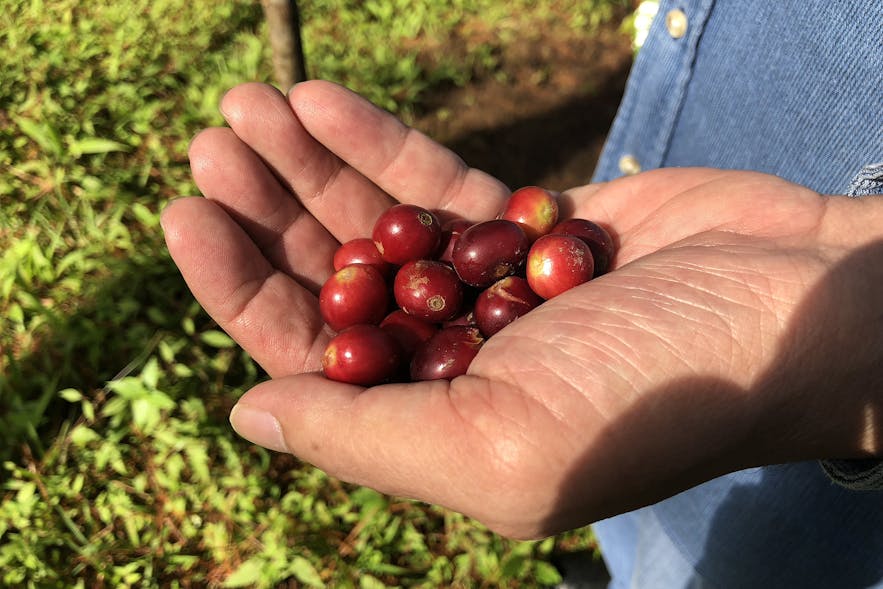
When it comes to coffee production, Cordillera’s Benguet has made quite a name for itself. Benguet is home to not only one but several thriving coffee farms.
One of the early farmlands established can be found in Kibungan, where thousands of Arabica seedlings have been planted by local farmers.
- Read our article about coffee in the Philippines
You can arrange a private vehicle to take you to Kibungan and other coffee sites like La Trinidad, Itogon, Tublay, and Atok. Another option is to book Benguet tours that include stops to these places.
See our popular Benguet Tours and Activities
Baguio religious sites tour with lunch & hotel transfers, baguio & benguet farms, gardens & museum tour with lunch & transfers, 6. davao .
Davao is the pride of Mindanao, the Philippines’ southern island. This cultural melting pot is home to top tourist spots and is rich with natural resources.
From sightseeing to diving, trekking, dining, and beach hopping, Davao tours generally have something for everyone to enjoy!
See our popular Davao Tours and Activities
Davao city tour b with transfers | philippine eagle center, people's park, malagos garden resort, 3-day stress-free package to davao at seda abreeza with breakfast & airport transfers, davao city tour d with transfers | crocodile park, people's park, d' bone collector museum.
If you want to be close to nature in a unique way and experience a simple and clean farm life, Davao is also a great destination.
Here are some of the leading farms in the region:
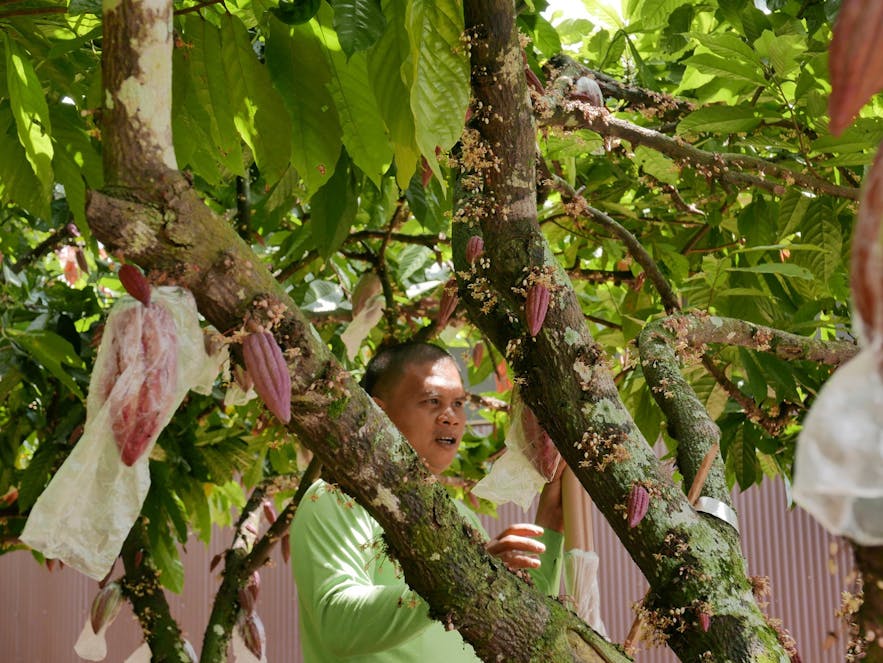
This impressive farm resort in the Baguio District of Davao promises to deliver an all-inclusive hospitable farm experience. Nestled at 300 meters above sea level, the farm has plenty of fresh air and scenic views.
Malagos Garden Resort tours include visits to their park, cafe, cacao farms, museums, and bird-feeding site. You may also choose to spend a night or two at this farm resort to really enjoy its serene and scenic environment.
DDavao is a go-to venue for growing and trading orchids. This is all thanks to its orchid farms including SUL Orchid
SUL Orchid Farm is one of the most prominent orchid farms in the country. It sits on 12 hectares of land in Davao’s Tugbok District.
While here, you will learn more about floriculture and see the biggest Vanda collections in the Philippines.
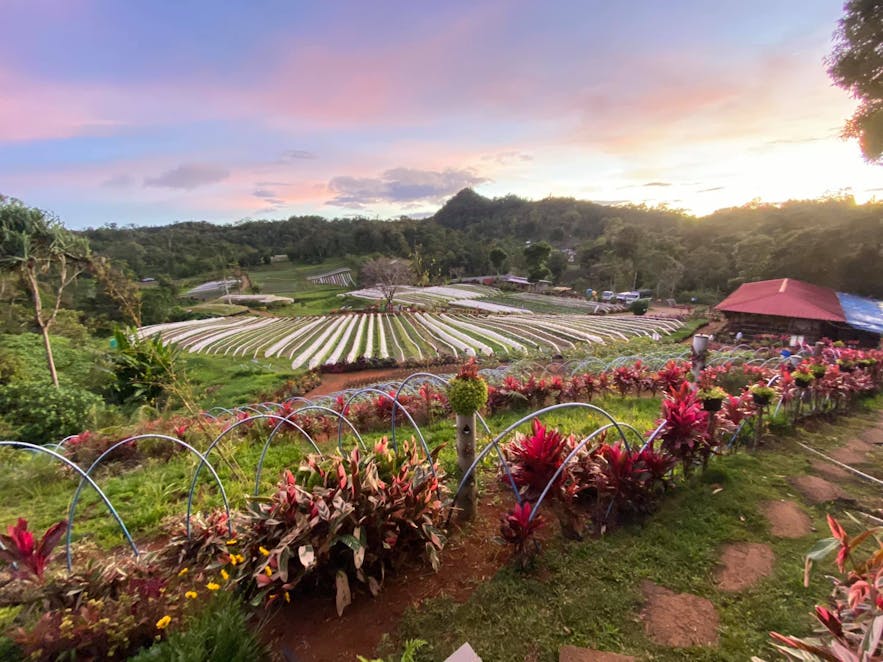
If you’re looking for a strawberry picking adventure in the southern Philippines, then Bemwa Farm is the place to go! Located in Marilog District, Buda, Bemwa is named after the initials of its five owners.
Bemwa presents a peaceful ambiance in a lush scenery and usually cool weather. Entrance to the farm is free and the main draw is strawberry picking. But you also have the choice to pick other crops like lettuce and sunflower.
5. Pangasinan
Located in the Ilocos Region of Luzon, Pangasinan is definitely one Filipino province that stands out when it comes to natural attractions and agri-tourism.
Most Pangasinan tours usually feature heritage sites and natural attractions like the Hundred Islands island hopping . They may also include visits to some of the province’s notable and government accredited farms.
See our popular Pangasinan Tours and Activities
Breathtaking 2-day pangasinan hundred islands shared tour from manila with hotel & nature trip, pangasinan hundred islands day tour with lunch & transfers, pangasinan shared tour to bolinao falls, church, cave, lighthouse with transfers from manila.
Some of the best farms in Pangasinan include:
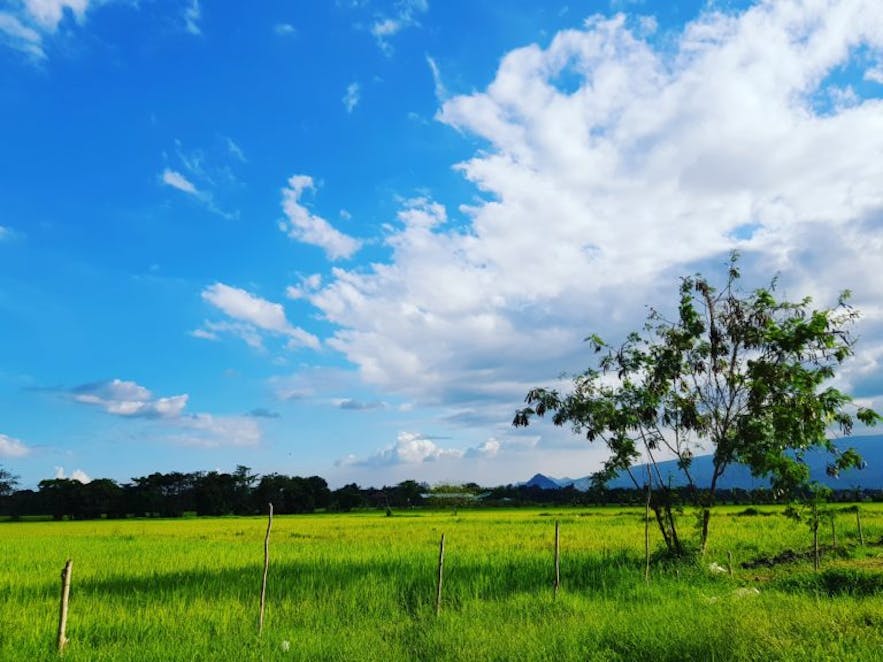
Our Farm Republic sits on a 5.8 hectare of land in the town of Mangatarem. It is an organic farm, which implements diversified and integrated farming techniques. It grows not only organic produce but also livestock and edible flowers.
Established in 2010, the farm gives a comprehensive tour that involves plant care and composting, crop picking, and dining at their farm-to-table restaurant.
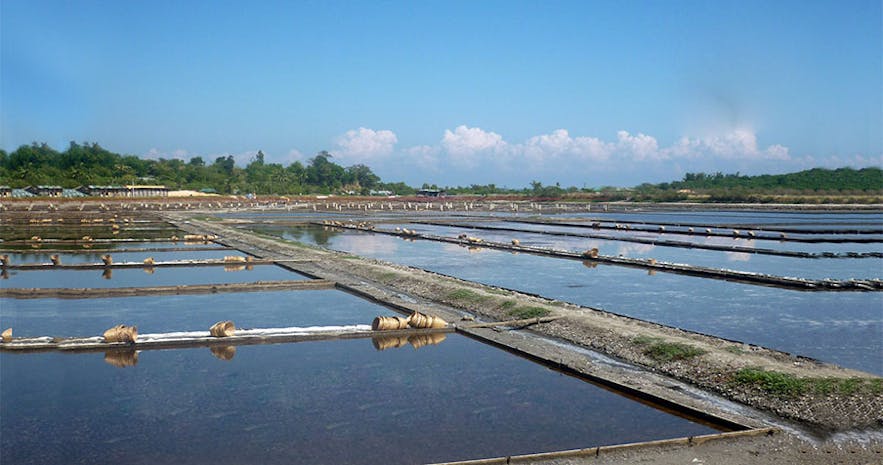
Pacific Farms is a 500-hectare, salt-making farm in Bolinao, Pangasinan. It’s actually the biggest salt producer in the country.
The highlight of your visit to Pacific Farms is its fun Agri-Eco tour, which features six-stop stations, which include a sunrise viewing deck, chapel ruins, salt harvesting, and stockpile sites, and a special bridge.
4. Batangas
Batangas sits on the Calabarzon region of Luzon island and has always been a popular holiday destination for Metro Manila dwellers.
Batangas tours usually explore beaches, diving spots, and the view of Taal Volcano and Lake. But agri-tourism is also very much alive in Batangas as it’s teeming with fertile lands, ranches, and farms.
See our popular Batangas Tours and Activities
Batangas canyon cove day pass with beach & main pool access, calatagan little boracay batangas beach tour from manila with tagaytay side trip & lunch, mount malarayat day hike with transfers from manila, certificate, drone coverage & souvenir.
Here are some the must-visit farms you should explore in Batangas:
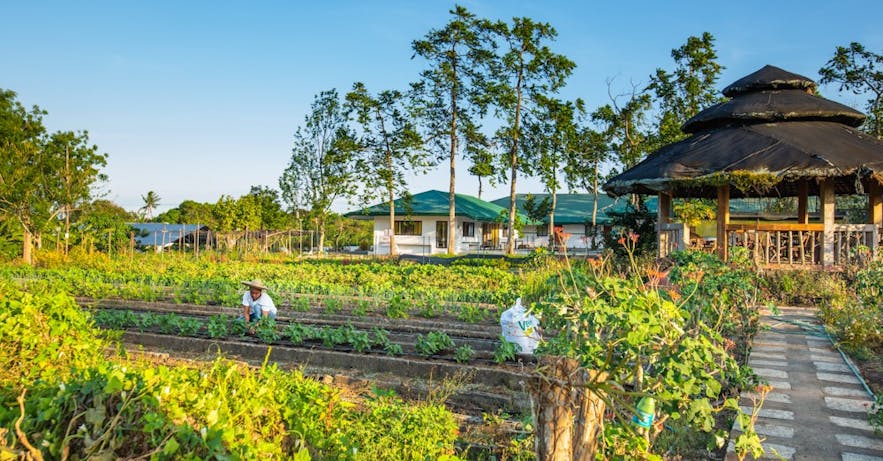
Located in Batangas City, Kahariam Farms is an accredited agri-tourism site by the Department of Tourism. The farm organizes tours and workshops on organic farming and raising black soldier flies.
This large farm is also a full recreational site with air-conditioned rooms, picnic area, basketball court, function halls, and swimming pools.

Located in Barangay Balagtasin, Lipa City, Milea Bee is one of the most popular farms in Batangas. This bee farm features not only bees but a lush surrounding endowed with colorful flowers.
Milea Bee Farm offers guided farm tours, which are usually arranged in advance. The farm aims to educate visitors not only about bee farming but why these creatures are important contributors to the development of our ecosystem.
Taal Maranan's Farmville Inc.
As the name suggests, Taal Maranan can be found in Batangas’ famous Taal town, specifically in Barangay Iba East.
This family-owned farm spans 5 hectares and treats its guests to various farming activities, rustic accommodation options, and farm-to-table dishes.
Taal Maranan also has a glamping (glamorous camping) site that lets you get close to nature without the nuances of traditional camping.
This large 9-hectare farm sits on the Tagaytay Ridge, Laurel Batangas, and can be accessed through the Tagaytay-Nasugbu Highway. Gorgeous Farm is a government accredited learning and agri-tourism site that promotes integrated organic farming.
The farm offers tours, which include trekking around its large property. You may also dine at their farm-to-table restaurant, stay overnight, or relax at their terrace, which gives fantastic views of Taal Volcano.
Chad’s Nature Farm
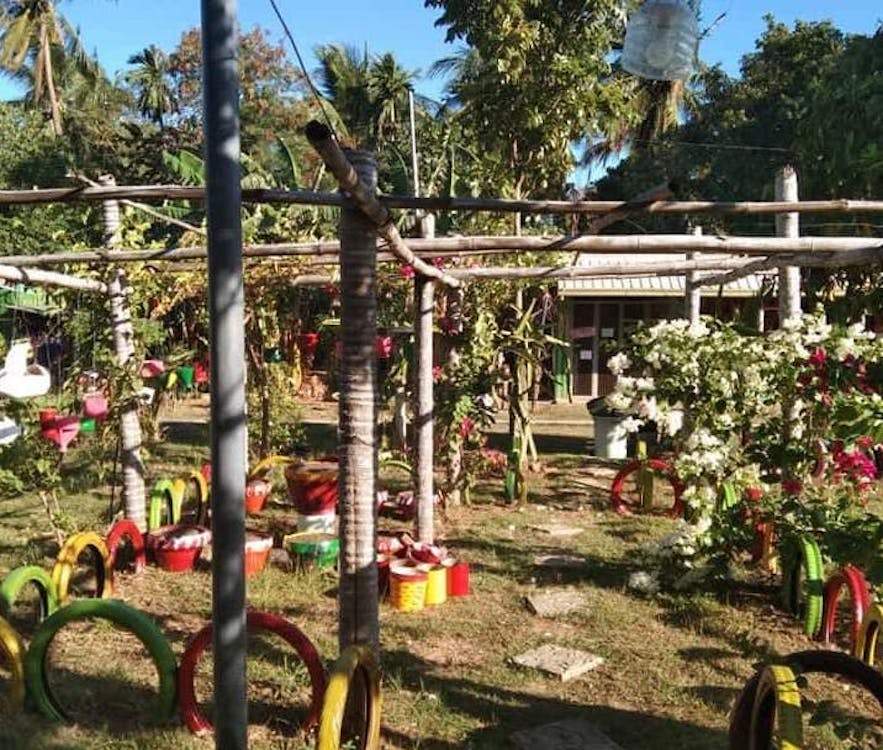
Located in Barangay Kinalaglagaan, Mataas na Kahoy, Chad’s Nature Farm was a simple retirement dream of a former government employee Aida C. Briones. The farm spreads to 1.5 hectares and is a School for Practical Agriculture (SPA) that teaches organic agriculture.
Here, you will learn how to care for livestock and grow organic produce. You can also participate in lectures and hands-on farming activities.
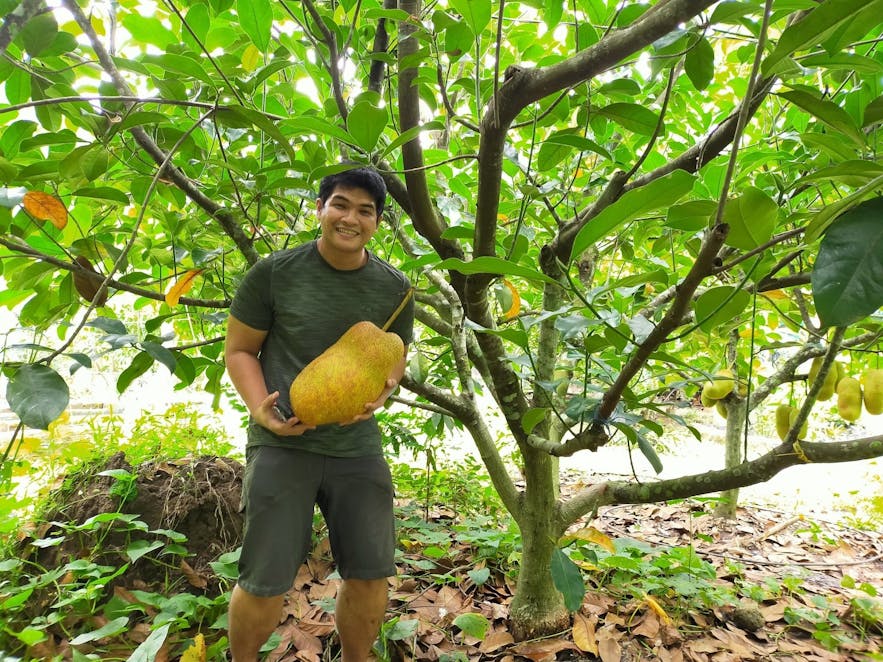
The Moca Family Farm is not just a business but a farm that has close relations to its local community. Situated in Padre Garcia, it is an accredited learning site and service provider for the regional government’s Agricultural Training Institute.
Moca Family Farm is an advocate and supporter of family farming. If you’re interested in how to start and run a family operated farm, then Moca makes a very worthwhile visit.
Often referred to as the “Surfing Capital of Northern Philippines”, La Union is already a popular tourist destination for domestic and international tourists. But aside from being a surging superstar, La Union is vying for another title.
By the year 2025, the province wants to be the Heart of Agri-Tourism in Northern Luzon. La Union plans to achieve this goal by using its vast experience in tourism and enhancing its tourist amenities and agricultural assets.
Here are some of La Union’s must-visit farms:
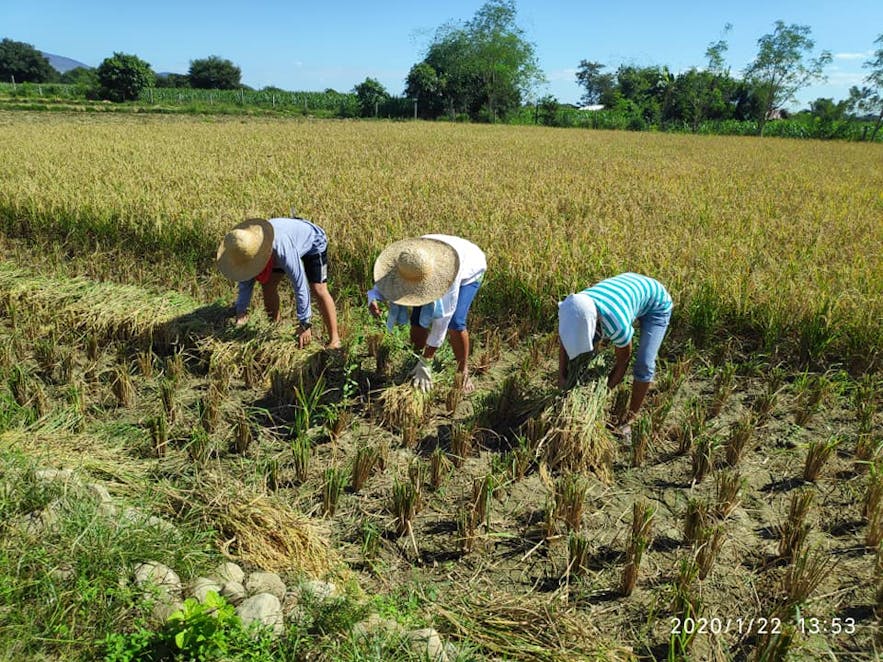
This organic farm is located in Barangay Tabtabungao and operated by a notable farm family in the region. Rocapor prides itself as an innovative organic farm that produces livestock, organic crops, and follows zero waste standards.
Rocapor organizes tours which highlight farm life activities. As a guest, you can pick, pay and bring home fruits and vegetables at affordable farm rates. The farm even sells livestock like goats, pigs, chickens directly to visitors.
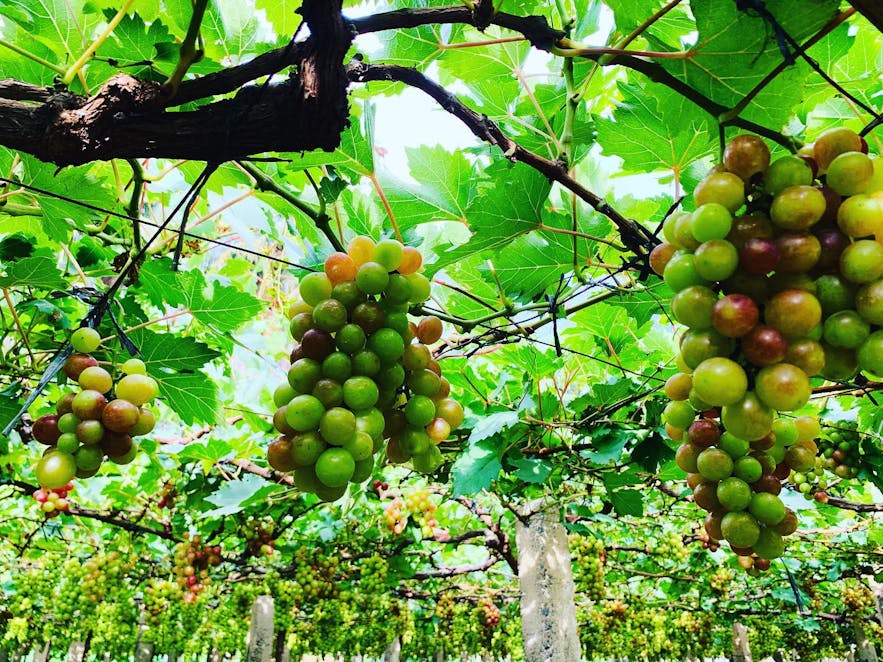
Lomboy Farms is situated in Barangay Urayong, Bauang, and is primarily a vineyard, established way back in 1972.
Lomboy is considered a pioneer of viticulture in the Philippines. Its founder, Avelino Lomboy, is referred to as the “Grape King”. Aside from grapes, it has expanded to growing dragon fruit and guapples.
Aside from exploring the farm, Graco also offers grape-picking from the end of March until May. You can pay for whatever you pick and also buy souvenir products like jams and wines.
You can find Bungol farm in Barangay Bungol, Balaoan. This farm is regarded as one of the largest producers of organic red and brown rice in the northern region of Luzon island. It is supported by the Provincial Government of La Union and has become a prime training center for rice growing.
On your visit to Bungol, you will learn a great deal about organic rice production and distribution.
Happy House Farm is all about educating its visitors with simple farming lifestyle and environmental conservation. At Happy House, you can enjoy the wonders of nature and the feeling of being lost in the countryside.
They have vegetable gardens, rice paddies, fishponds, lots of trees plus sea views! It is a truly serene spot to bask in nature for a day.
2. Cavite
Situated in the Calabarzon region of Luzon, the province of Cavite is a historical gem being the site of the nation’s first declaration of independence.
Aside from exploring the province’s historical and cultural sites, you can also find Cavite tours that highlight the region’s thriving agri-tourism scene.
Some of the most notable farms in Cavite include:

Gourmet Farms claims to be the first farm to introduce Philippine coffee beans to the rest of the world. On top of coffee, the farm has also found success in producing organic lettuce, herbs, and tea.
Located in Silang, Cavite, it is the perfect tourist destination for coffee lovers and nature enthusiasts.
Yoki's Farm
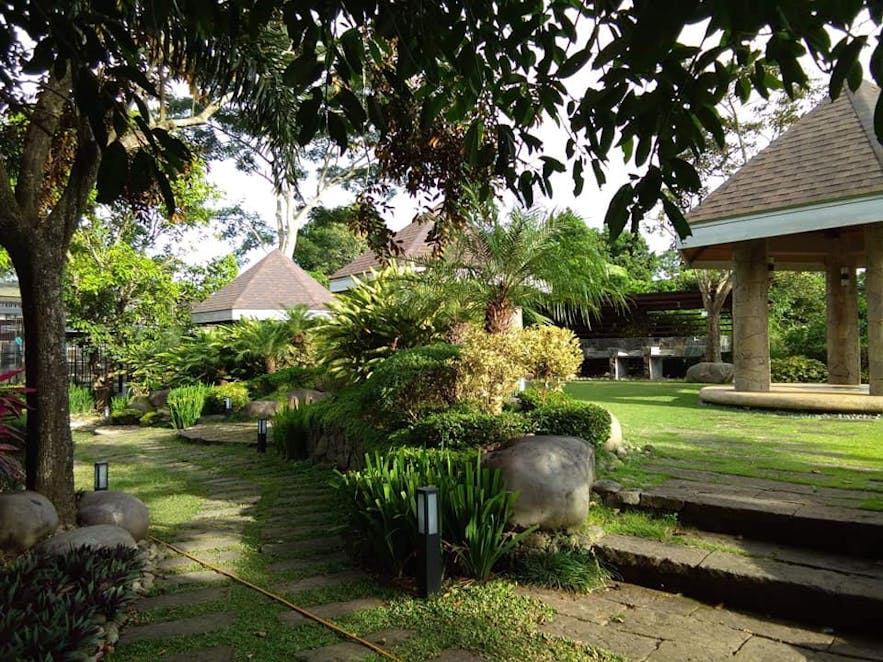
The town of Mendez is the home of the 10-hectare Yoki’s Farm, another prestigious farm that Cavite is proud of.
Yoki’s is the ultimate farm resort. On top of the usual farm tour, it also runs a museum, a zoo, an orchidarium, a hydroponics farm and a farm-to-table restaurant that has an all-day breakfast menu! You can even spend a night or two at one of their onsite guest rooms.
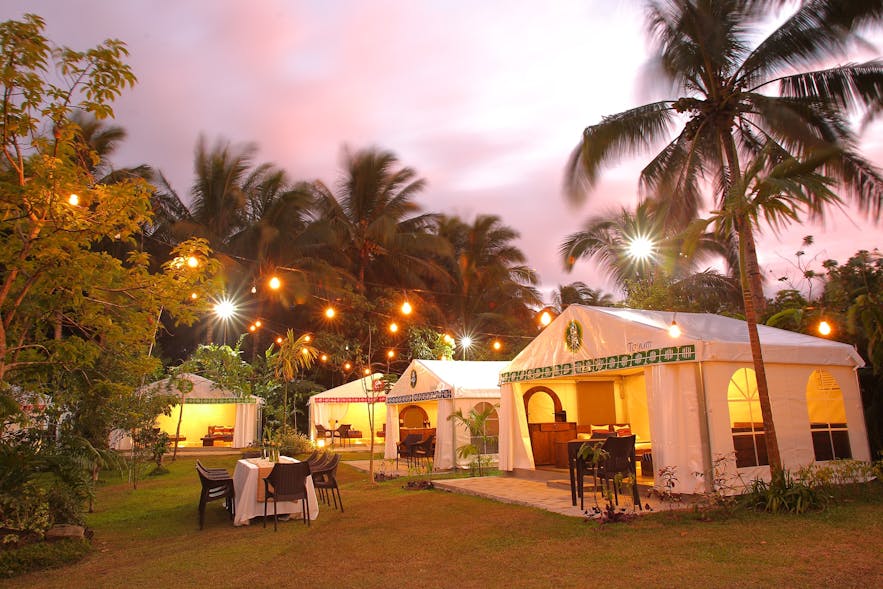
Nurture Farmacy is no ordinary farm; it is designed to be a complete tourist attraction.
This farm, which advocates organic farming, is located within Nurture Wellness Village in Tagaytay. A tour of the Nurture Farmacy teaches you the health benefits that their produce and medicinal plants can provide.

You can find The Coffee Farmhouse in Barangay Palumlum, Alfonso, Cavite. This farm is close to Tagaytay and is only about a 2-hour drive from Manila.
The Coffee Farmhouse runs a coffee tour for visitors and operates its own restaurant and bed-and-breakfast. Other facilities include a swimming pool, basketball courts, bicycle, and scooter rental, and camping grounds.
Teofely's Nature Farm, Inc

Teofely's Nature Farm can be found on the outskirts of Silang Municipality. It encompasses 6,600 square meters of land and is a government accredited farm school.
Teofely is dedicated to practicing organic farming. Aside from growing vegetables, Teofely’s expertise also lies in raising native pigs.
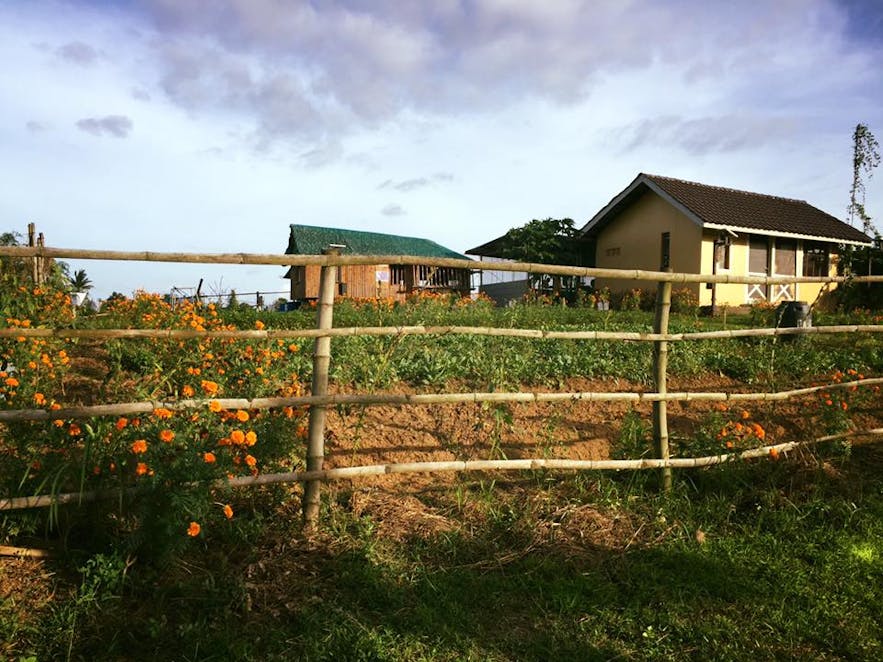
Terra Verde is located in Cavite’s Maragondon Municipality. Although day visits are possible, it’s better to avail of Terra Verde’s overnight packages to fully enjoy their authentic farm setting.
The tour package teaches you about how to run a farm while using the best available agricultural practices. You will get to actually do farm chores like feeding the chicken in the morning.
1. Laguna
Laguna is a prominent province in the Calabarzon region of Luzon island. Because of its proximity to Metro Manila, the province is a favorite domestic tourism destination.
There are plenty of Laguna tours to natural attractions like lakes, waterfalls and hot springs. But you may want to consider visiting some of Laguna’s premier farms, which have become leading agri-tourism destinations in the country.
See our popular Laguna Tours and Activities
Enchanted kingdom day pass with unlimited rides and optional bus transfers, laguna mt. romelo & waterfalls shared minor day hike with transfers from manila, san pablo laguna tour to heritage and museum sites with snacks & souvenir.
Some of these premier Laguna farms are:
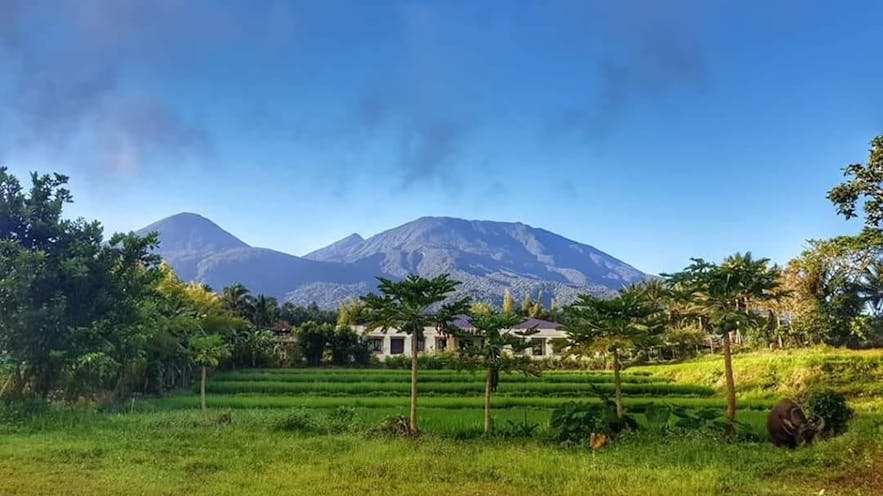
Located at the foothills of Mount Banahaw in Majayjay Municipality, Costales Nature Farms makes a fantastic agri-tourism destination because it adheres to integrated organic farming that's nature friendly and sustainable.
Currently, the farm offers one-day or two-day tour packages, which include not just the tour but a comprehensive lecture on organic farming.
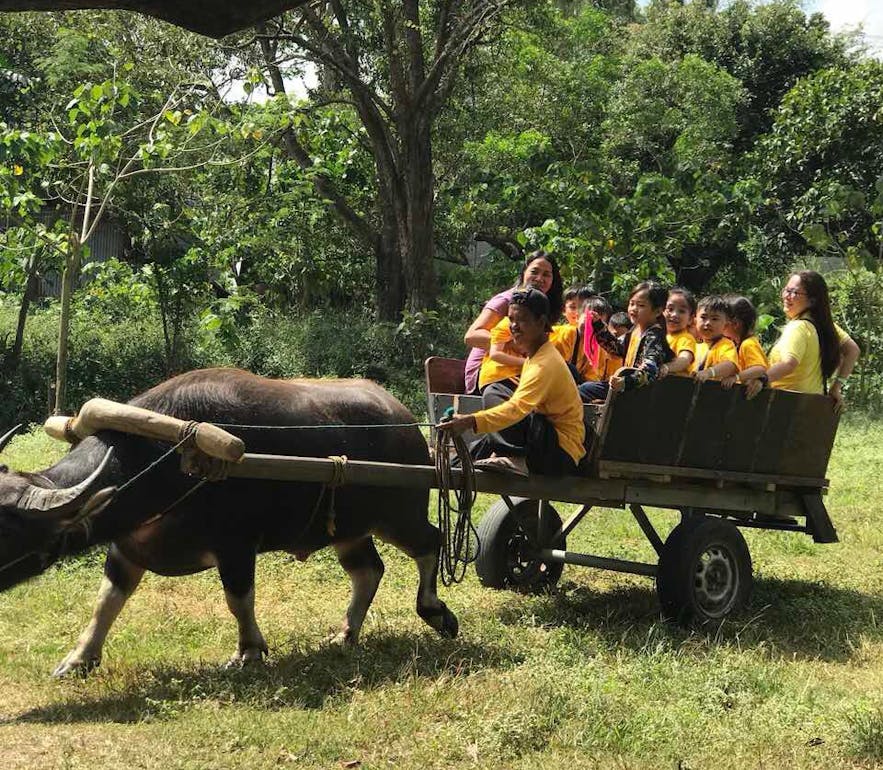
Holy Carabao is based in Santa Rosa, Laguna, and is quite accessible from Manila.
- Book an Enchanted Kingdom ride all you can day pass
Holy Carabao is dedicated to producing healthy food fit for Filipino families. The farm’s guided tour highlights its version of holistic farming, which emphasizes organic growing, biodynamic, and permaculture.
Situated in Barangay Santa Elena San Pablo City, Forest Wood is one of the most picturesque farms in Laguna. Here you will find an abundance of coconut trees, forest trees, and other fruit trees.
Forest Wood’s tour showcases their unique farming style and rich forest environment. The farm’s restaurant is a must-try as it serves homegrown specialty root crops such as taro, yellow yam, and cassava.
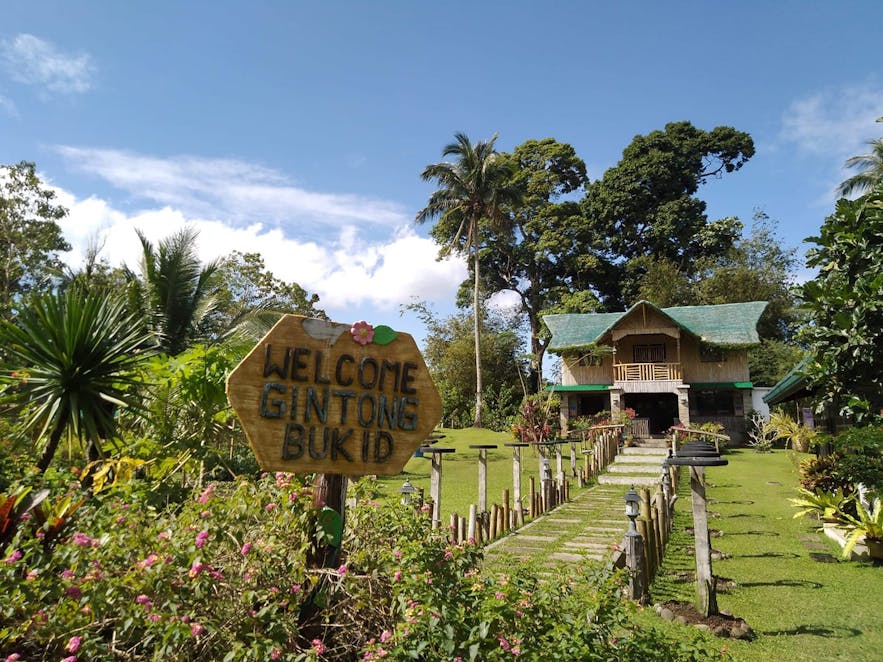
Gintong Bukid Eco Farm is a premier agri-tourism site found in Nagcarlan, Laguna.
At Gintong Bukid, you will learn about “eco-farming”, which is a farming style in unison with nature. This means that the farm shies away from harmful chemical pesticides and fertilizers or genetic modifications. Even the farm animals are being fed with organic produce of the farm.
Ato Belen’s Farm
Located in San Pablo Laguna, Ato Belen’s Farm is a leading site for diversified and integrated farming in the Philippines.
A tour of this farm is mainly learning about crop production, organic farming, and animal farming. The farm is also known for its farm operation and management lectures.
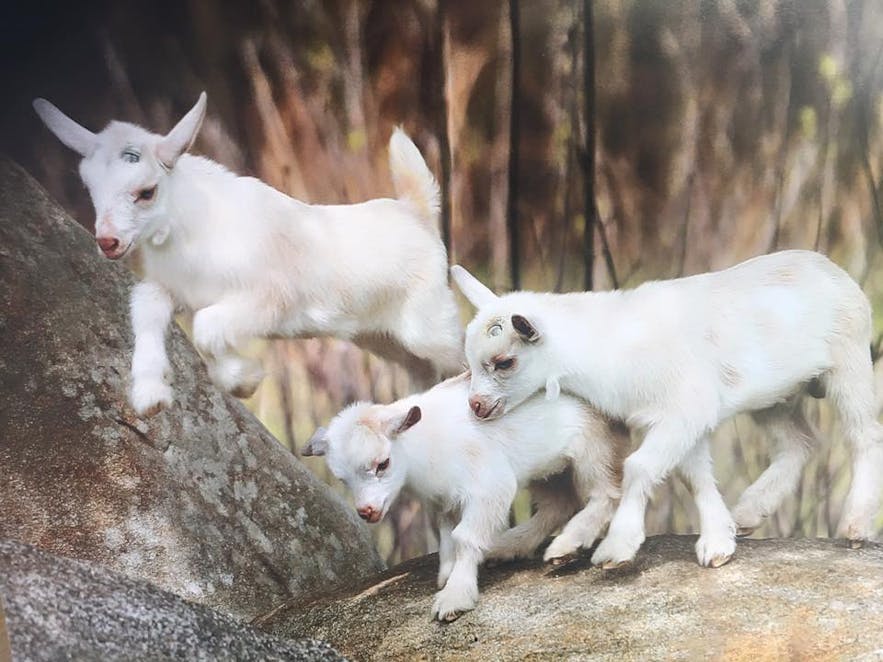
Graco Farms is tucked in the secluded and serene area of Pila, Laguna. It is mainly a goat farm but has expanded to raising other livestock.
Some of the activities to be enjoyed at Graco Farms are goat feeding, fishing, and picking organic vegetables.
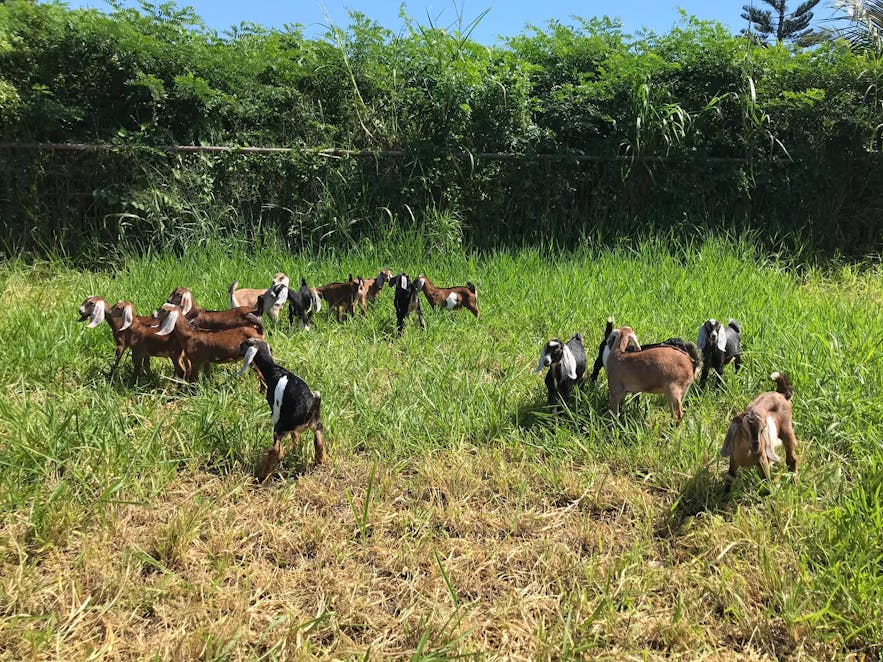
This prestigious goat farm is situated in Barangay 2 of Alaminos, Laguna, and specializes in breeding full-blood Boer goats.
Alaminos Goat Farm welcomes visitors from all over and hopes to share their expertise and experiences in raising highly-priced goats.
Explore the Farm Tour Destinations of the Philippines
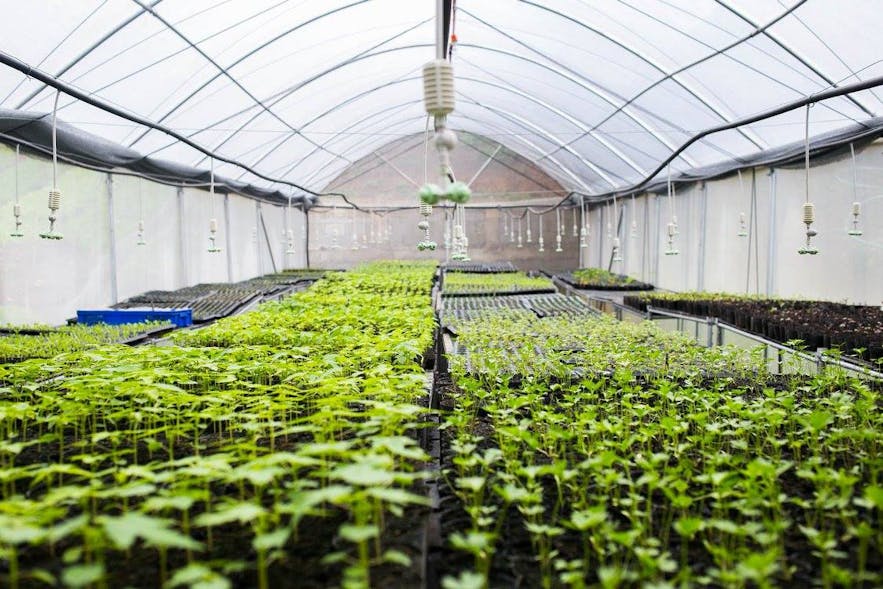
There you have it, the 10 best farm tour destinations in the country. These farms have greatly contributed to the improvement of the Philippine agricultural industry. At the same time, they have also developed activities and amenities for outsiders to appreciate agriculture and farm living, while having fun!
Agri-tourism perfectly combines the elements of travel, education, environment conservation, and cultural appreciation. And the Philippines is a prime destination to experience agri-tourism at its best! Check out other reasons why you should visit the Philippines .
Check out the farm tours that you can book for your next getaway in the Philippines.
Popular articles

Best Palawan Guide: Top Tours, Where to Stay, How to Get Around

20 Most Beautiful Sandbars in the Philippines: White Sand, Longest, Vanishing

11 Best Santorini-Like Resorts in the Philippines: Near Manila, Cebu, Palawan, Vigan

15 Best Tropical Bali-Like Resorts in the Philippines: Near Manila, Siargao, Cebu, Bohol

10 Best Treehouse Resorts in the Philippines for a Scenic Getaway at Mountains, Beaches & Rivers
Other interesting articles.

3 Weeks Itinerary in the Philippines: Best Places to Go, Must-Do Tours & Activities

Travel Guide to Buscalan Tattoo Village in Kalinga: Home to Apo Whang-Od

11 Best Hotels Near Manila Airport NAIA: 5-star Luxury Hotels, Budget-friendly, Best View

Download the Philippines’ biggest travel marketplace to your phone to manage your entire trip in one place
Scan this QR code with your phone camera and press the link that appears to add the Philippines’ biggest travel marketplace into your pocket. Enter your phone number or email address to receive an SMS or email with the download link.
Top things to do in the Philippines
Discover all the adventures you can experience in the Philippines

Philippines Tour Packages

Boracay Island

Bohol Island

Cebu Island

Coron Palawan

El Nido Palawan

Siargao Island

Iloilo City and Nearby

IMAGES
VIDEO
COMMENTS
Farm tours show a dedication to transparency, and an effort towards sharing our farming stories. Also, research has shown that one person will share their experiences with 22 others - good or bad. If you can provide one positive experience on a farm tour, that person will then share their positive vibes with 22 of their friends and family ...
Promoting the tour. Promoting farm and ranch tours is not just limited to websites and social media. Partnering with other businesses to cross-promote can be beneficial for all involved. For instance, if a berry farm sells its products to a bakery for pies, the bakery may advertise for the farm tours.
Farm tours are important for many reasons. With most of the population at least two generations removed from farming, it gives people interested in how food is produced an opportunity to make connections with farmers. Many people talk about food, its nutritional value or how to cook it, but have never actually visited a farm, talked to a farmer ...
Although the definition of a family farm has changed somewhat over time, the share of U.S. farms classified as family farms has changed little, dropping only as low as 97.1 percent in 2005 and 2006. Farm Operator Household. Farm operator households are comprised of all people who share dwelling units with the principal operators of family farms.
The bill defines "agritourism activity" broadly as any activity carried out on a farm or ranch that allows members of the general public, for recreational, entertainment, or educational purposes, to view or enjoy rural activities . . . [including, but not limited to]: farming; ranching; historic, cultural, and on-site educational programs ...
- The definition of a household; - The characteristics that distinguish an agricultural household from any other. Both 'household' and 'agricultural household' (or 'farm household') are familiar terms. However, behind this common usage lie a variety of meanings that must be clarified and used with discrimination when
Farm households typically receive income from both farm and off-farm sources. The well-being of farm operator households often relies more on their nonfarm activities and investments than on their farm businesses. Research and data provide information on the sources of farm household income and wealth, the farm-nonfarm allocation of work and investments by farm household members, and other ...
An agriturismo is a farm stay, or a style of vacationing in farm house resorts. In Italy, many agriturismi (the plural of agriturismo) are generally suitable for the whole family, and many have farm animals with which children can interact. Others are more romantic and perfect for a couples' getaway. Despite the quaint-sounding name, many ...
Mean and median farm operator household income and ratio of farm household to U.S. household income, 1960-2022: 11/30/2023: 12/3/2024: All farms and family farms by farm size class (gross sales), 1996-2022: 11/30/2023: 12/3/2024: Farm Household Characteristics: Characteristics of principal farm operator households, by experience of ...
What follows are six insightful U.S. farm tours offering a behind-the-scenes look at modern agriculture, from organic cranberry farming in Cape Cod to goat milking in South Carolina. Visitors to Ostlie's in North Dakota can learn about hops, hardneck garlic, and haskap berries during a tour. Lindsay and Mike Ostlie may grow haskap berries and ...
Agritourism is important both for the farms and the consumer. Offers farmers need a way to diversify their revenue by providing additional income through tours, sales of products, event space, farm stands, or even a place to stay. It provides educational opportunities to the community such as the ones mentioned above.
November 8, 2020 Justin Moore. Homegrown | Agritourism in North Carolina. Watch on. Agritourism - a hybrid of agriculture and tourism - refers to activities or events that take place on working farms for the enjoyment and education of the public. Farmers increasingly rely on agritourism to support the family farm and strengthen their ...
The other part examined independent variables, including household information, land consolidation, market advantages, institutional arrangements, and cognitive awareness of tourism. The larger the value in the sequencing variables is, the higher the level of variables is. The meaning and value of specific variables are shown in Table 1.
FAO's definitions of family farming. Substantive definition: Family farming is "a means of organizing agricultural, forestry, fisheries, pastoral and aquaculture production which is managed and operated by a family and predominantly reliant on family capital and labour, including both women's and men's. The family and the farm are linked, co-evolve and combine economic, environmental ...
Fair Oaks Farms (IN) One of the farms that is set up to provide comprehensive tours is Fair Oaks Farms in northwestern Indiana. It has a large, modern dairy farm as well as pork and crops and they have a visitor's center, a cafe and a restaurant as well as tours around the property to see how a bigger farm works.
A farm stay is a unique opportunity to get away from the normalcy of fast-paced tech-filled living and get back to nature. It's a time for you to connect with your inner soul and nature which can be a very healing and purifying experience. There is a sense of grounding you will experience during your time on the farm.
Definition 1. Households where the cultivated area of the farm is over two hectare are counted as farmer households. A household is not considered a farmer household if the main source of income reported is renting of fields, compensation for reduction or cessation of agricultural production or if no income is derived from the farm.
Your paid tour ticket grants you access to enjoy our entire 15-acre farm located on our property at your leisure. Check out the one-room schoolhouse, see demonstrations by our resident artisans, and much more!. Thursdays-Saturdays the BBQ Barn is open with grilled chicken, ribs, sandwiches, soft pretzels and ice cream. Enjoy your picnic-style meal right on the farm.
If you're new to the Farmhouse Living blog, once a month mom and I share a home tour of another homebody that has tons of inspiration to give. Today we're sharing KariAnne's of Thistlewood Farms 110-year-old farmhouse. KariAnne's joy and passion are contagious. This home is her childhood home so she shares so many fun stories and ...
Farm tourism is a rising industry in the country. Institutions and enterprises see why farm tourism is valuable and important. Learn more about it here.
feasible set (perhaps particularly the farm production function) or on the household utility function. Ideally, we'd like to use data to allow us to recover both Uand; then we'd have a complete model of the farm-household. In practice, this model may be too simple to capture important elements of the problem facing the farm-household. We ...
2. Cavite. Situated in the Calabarzon region of Luzon, the province of Cavite is a historical gem being the site of the nation's first declaration of independence. Aside from exploring the province's historical and cultural sites, you can also find Cavite tours that highlight the region's thriving agri-tourism scene.
Related to Farm household. Farmworker Household means a household of one or more persons wherein at least one member of the household is a Farmworker at the time of initial occupancy. Household means a family group living in the same domestic dwelling. Head of household means the parent or parents with whom the dependent child or children were ...